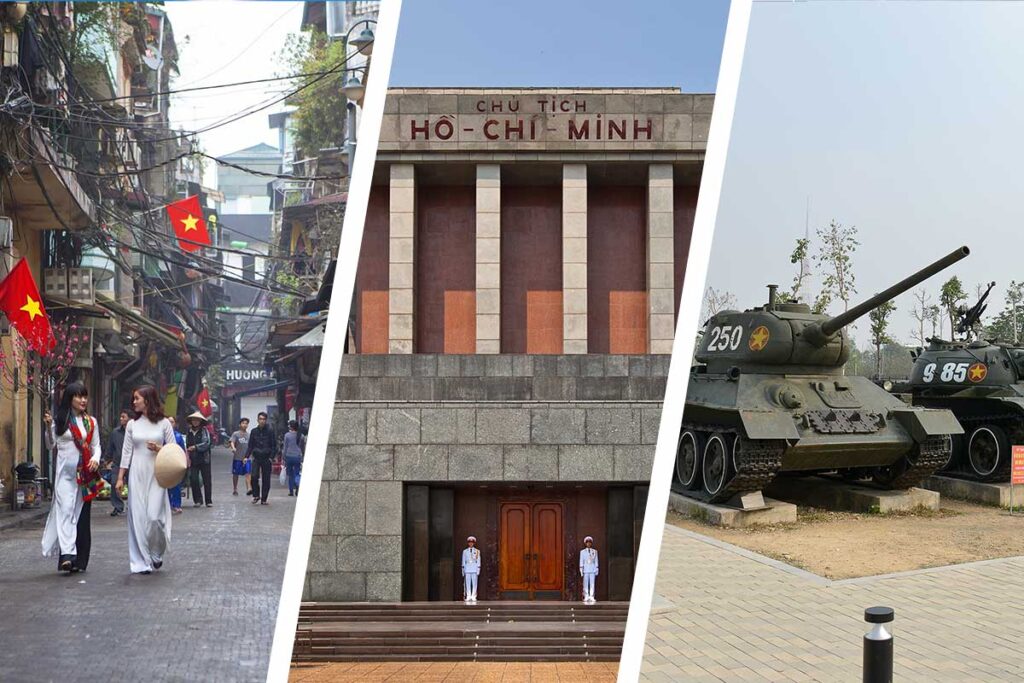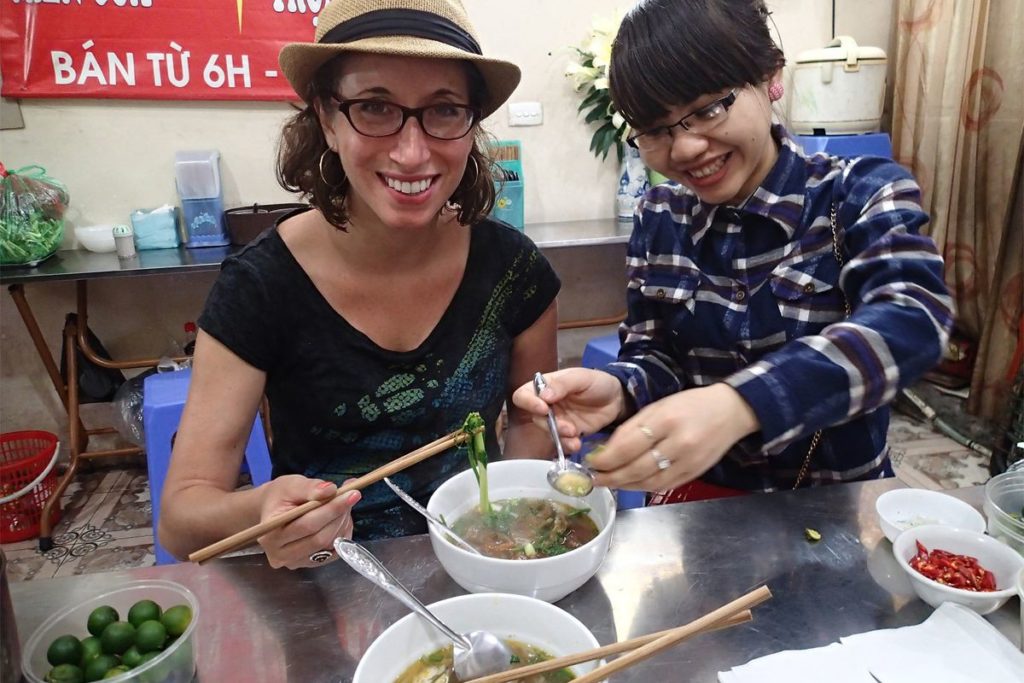Is 3 days in Hanoi enough?
Yes — 3 days is a great amount of time to explore Hanoi without feeling rushed. Two full days are usually enough to cover the city’s most important historical and cultural highlights, especially if you plan well.
The third day gives you flexibility. You can slow down and dive deeper into museums, take longer walks, or simply enjoy the café culture. Or you can use it to explore places that most tourists skip — like local parks, lesser-known markets, or quiet streets in the French Quarter.
It’s a smart amount of time if Hanoi is one stop on a longer Vietnam itinerary. You’ll leave with a real sense of the city, while still having time to enjoy other regions.
Where to focus on in 3 Days in Hanoi
We’ll divide your time by neighborhood — the easiest way to organize sightseeing in a large and layered city like Hanoi. The first two days focus on the must-see sights and areas. The third day gives you space to revisit missed highlights or explore beyond the usual tourist trail.
Day 1: Hoan Kiem District – Old Quarter & French Quarter
The city’s historic and cultural core. Expect narrow alleys, bustling markets, colonial architecture, iconic lakes, temples, and some of the best street food in Vietnam. It’s a sensory overload — but in a good way.
Day 2: Ba Dinh District
The political and spiritual center of Hanoi. Home to the Ho Chi Minh Mausoleum, the ancient Thang Long Citadel, historic pagodas, and war museums. It’s more spread out, but rich in national significance.
Day 3: Missed Highlights or Outer Hanoi
Use this day to go deeper. Revisit areas you didn’t have time for, or focus on overlooked places like old book streets, local parks, and fabric markets. If you’re up for a longer journey, we also include ideas for exploring Hanoi’s outer districts, traditional craft villages, or even quick day trips to nearby provinces.
Where to stay for 3 Days in Hanoi
Old Quarter
Still the best base for a 3-day Hanoi trip. You’re close to street food, Hoan Kiem Lake, walking streets, and many key sights — especially those on day one. It’s lively, central, and walkable, making it easy to return in the evenings even if you explore farther during the day.
French Quarter
A quieter, more elegant alternative. This area has wide boulevards, colonial buildings, and is close to museums and landmarks like the Opera House. It’s great if you enjoy peaceful walks and want a less hectic atmosphere without being too far from the action.
West Lake
Scenic and popular with expats, this area is more laid-back and modern. It’s not far, but you’ll rely on short taxi or Grab rides to reach most sights. A good choice if you prefer a calm vibe, café culture, and sunset views after sightseeing.
Quick Overview – 3-Day Hanoi Itinerary by Time
Below is a quick reference for how to spend 3 days in Hanoi, broken down by day and time of day. Each day focuses on a different side of the city — from must-see sights to deeper cultural layers.
Day 1 – Old Quarter & French Quarter
| Time | Activities |
|---|---|
| Early AM | Long Bien Bridge (optional sunrise) |
| Morning | Dong Xuan Market → Pho Breakfast → Walk through the Old Quarter |
| Midday | Hoan Kiem Lake → Ngoc Son Temple |
| Afternoon | St. Joseph’s Cathedral → Lemon Tea → Hoa Lo Prison |
| Evening | Street Food Tour (includes Train Street) → Bia Hoi Corner or Rooftop Bar |
Day 2 – Ba Dinh District & West Lake Extension
| Time | Activities |
|---|---|
| Early AM | Temple of Literature |
| Morning | Lenin Park → Hanoi Flag Tower → Imperial Citadel |
| Midday | Ba Dinh Square → Ho Chi Minh Mausoleum → Ho Chi Minh Museum |
| Afternoon | One Pillar Pagoda → Ho Chi Minh’s Stilt House → Quan Thanh → Tran Quoc Pagoda |
| Evening | Water Puppet Show (near Old Quarter) |
Day 3 – Missed Highlights, Culture & Relaxation
| Time | Activities |
|---|---|
| Early AM | Vietnam Military History Museum (option to detour via B-52 Lake) |
| Morning | Ly Thai To Park → Toad Fountain → Dinh Le Book Street |
| Midday | Opera House → Vietnam National Museum of History |
| Afternoon | Hom Market (fabric section) → Thong Nhat Park |
| Evening | Return to Old Quarter → Souvenirs, final Bia Hoi, or farewell stroll |
Hanoi in 3 Days – Full itinerary with Highlights
This itinerary is designed to help you make the most of 3 days in Hanoi — starting with the city’s historic heart, followed by its cultural landmarks, and finishing with deeper or lesser-seen places. Day 1 focuses on the Old Quarter and French Quarter, the most atmospheric and walkable districts in Hanoi.
Day 1: Old Quarter and French Quarter
Your first day is all about the heart of Hanoi — starting in the buzzing Old Quarter, where history and street life blend into one, and ending with a touch of elegance in the French Quarter. Expect narrow alleys, sidewalk culture, classic Hanoi dishes, and colonial architecture.
1. Sunrise at Long Bien Bridge (optional)

To make the most of your 3 days in Hanoi, start with a quiet walk across Long Bien Bridge — one of Hanoi’s most atmospheric landmarks. Built by the French in 1899, this rusty steel bridge stretches over the Red River and offers sweeping views of banana plantations and floating market boats below.
In the soft morning light, you’ll see locals biking to work, carrying vegetables to market, or just taking in the air. It’s a peaceful contrast to the chaos that will soon fill the city.
Tip: From here, it’s a short walk to Dong Xuan Market to catch the early-morning rush.
2. Dong Xuan Market – Morning Buzz
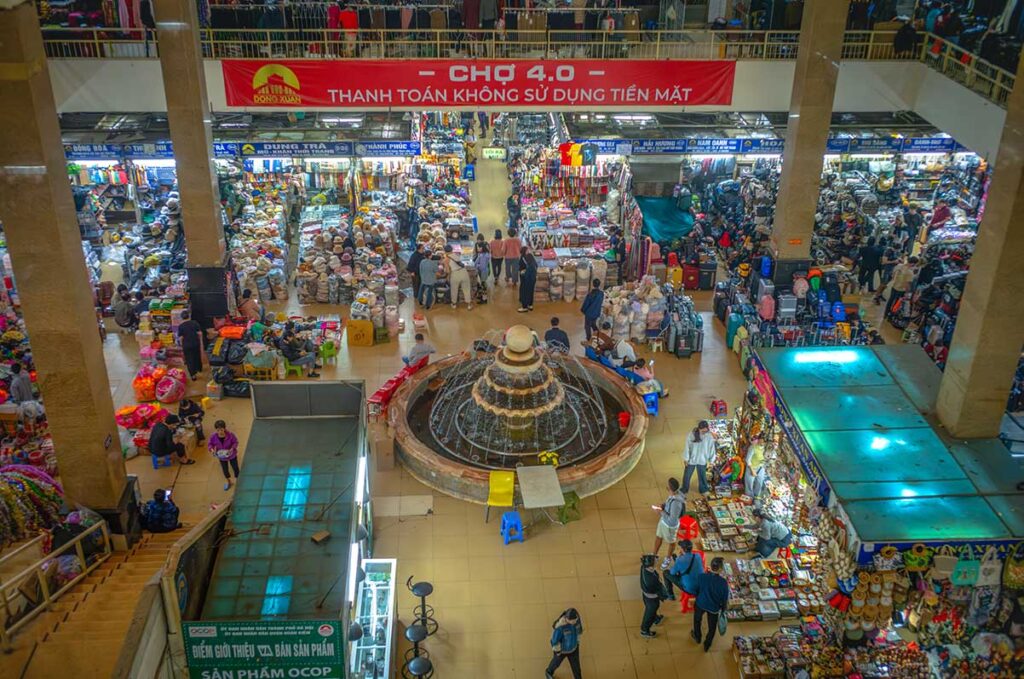
Just down the street of the bridge lies Dong Xuan Market — the city’s largest indoor market. But while the warehouse-style interior sells clothing, souvenirs, and bulk goods, the real energy is in the surrounding streets.
Come in the morning to see local vendors selling produce, meat, and herbs right on the sidewalks. It’s not curated for tourists, which is exactly the appeal — pure, loud, authentic Hanoi. Even if you don’t buy anything, it’s a perfect slice of daily life.
3. Pho Breakfast at a Local Spot
After the market, it’s time for a steaming bowl of pho — Hanoi’s signature breakfast dish. Choose beef (pho bo) or chicken (pho ga), and look for small places packed with locals. That’s where you’ll find the best broth.
Popular options include:
- Pho Gia Truyen (49 Bat Dan) – famous, but often a queue
- Pho 10 Ly Quoc Su – another local favorite
- Or just follow your nose and go where the broth smells rich and the stools are plastic.
Expect fast service and bold flavors — this is how Hanoi starts its day.
4. Walking the Old Quarter – Culture & Chaos
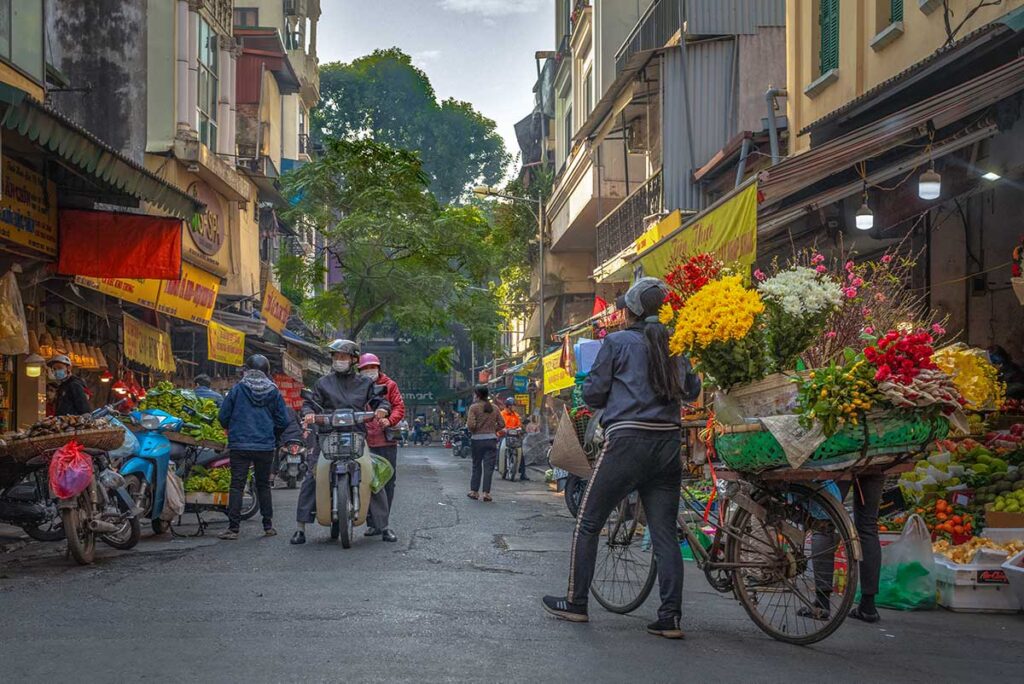
With pho in your belly, spend the rest of the morning exploring the Old Quarter — a 1,000-year-old maze of narrow streets, noisy scooters, and hidden charm. Each of the “36 Streets” is named after an old guild (like Silver Street, Paper Street, Bamboo Street), though today they sell just about everything.
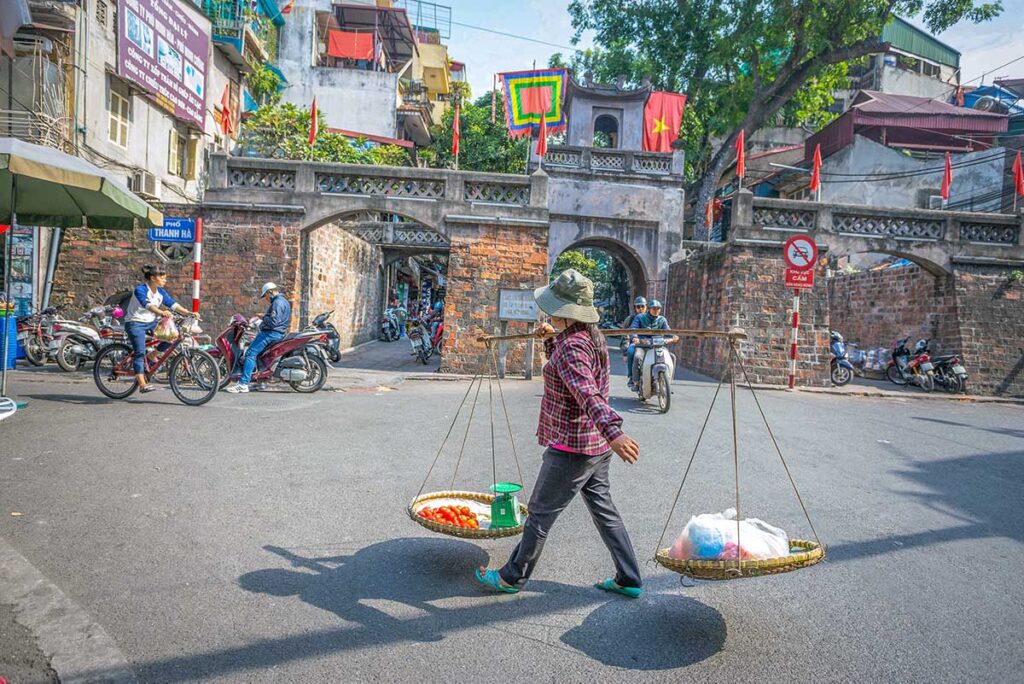
Key cultural stops along the way:
- Hanoi Old City Gate – the last surviving gate from the city walls
- 87 Ma May Heritage House – a well-preserved tube house showing traditional life
- Bach Ma Temple – one of the oldest temples in Hanoi, linked to the city’s founding
Even without a set plan, wandering is half the fun. For deeper insight, you can also book a local guide who knows the hidden corners.
5. Hoan Kiem Lake + Ngoc Son Temple
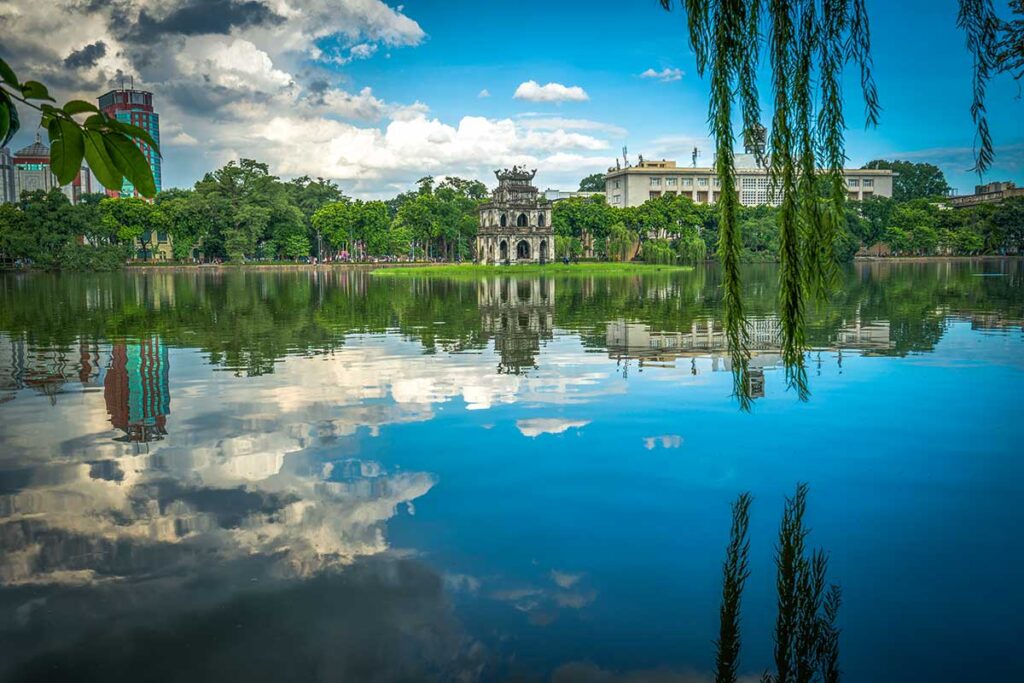
End your morning with a stroll around Hoan Kiem Lake — the symbolic heart of Hanoi. Locals come here to walk, relax, or people-watch on shaded benches. It’s calmer than the Old Quarter but still full of life.
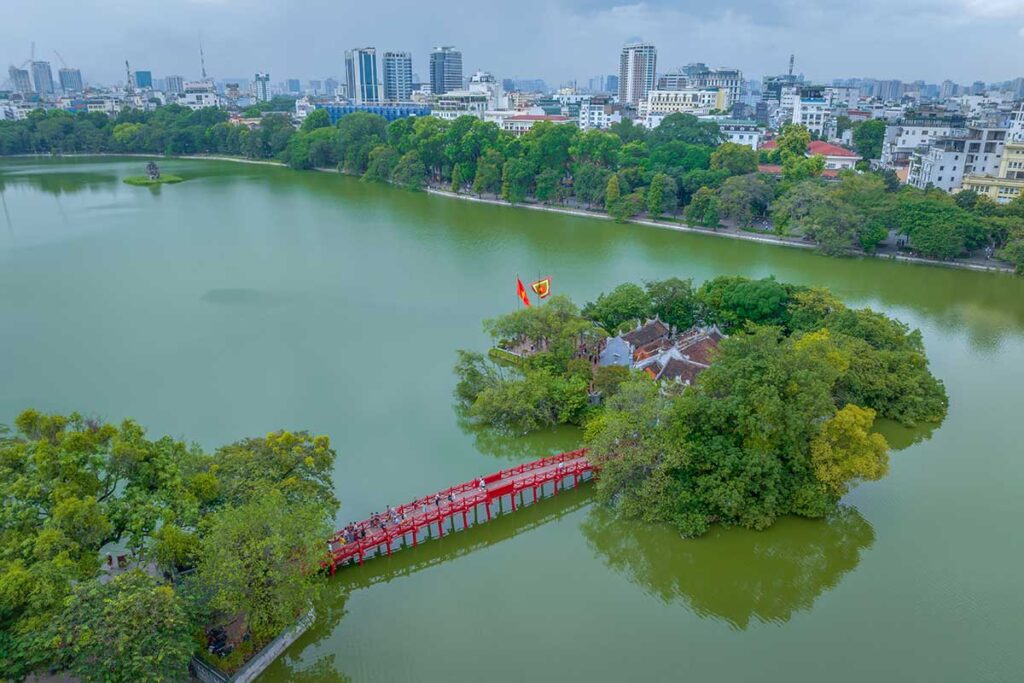
Cross the bright red Huc Bridge to reach Ngoc Son Temple, located on a small island in the lake. Inside you’ll find altars, cultural relics, and a giant preserved turtle — a nod to Hanoi’s founding legend.
- Entrance: 30,000 VND (~$1.20 USD)
- Time: 30–45 minutes (including a full lake loop)
This is a great place to slow down before heading into the grander boulevards of the French Quarter.
6. St. Joseph’s Cathedral + Lemon Tea Stop
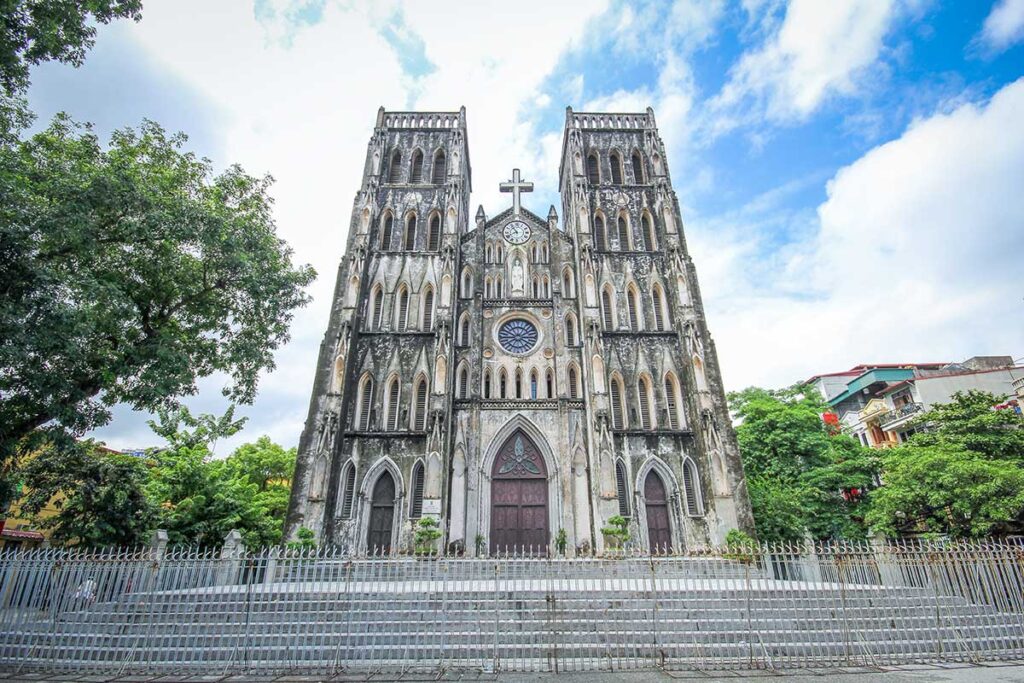
From Hoan Kiem Lake, it’s a short walk to St. Joseph’s Cathedral, one of Hanoi’s most striking colonial-era buildings. Completed in 1886, the church is modeled after Notre-Dame in Paris, with neo-Gothic towers and weathered stone walls that contrast beautifully with the scooters zipping past.
Even if you don’t go inside, it’s worth seeing from the small plaza out front — especially in the late morning or early afternoon when it’s less crowded.
Tip: Grab a lemon tea (tra chanh) or Vietnamese iced tea at one of the casual tea shops near the church, especially along Nha Tho Street. It’s a popular hangout for local youth and a great spot for people-watching.
7. Hoa Lo Prison Museum
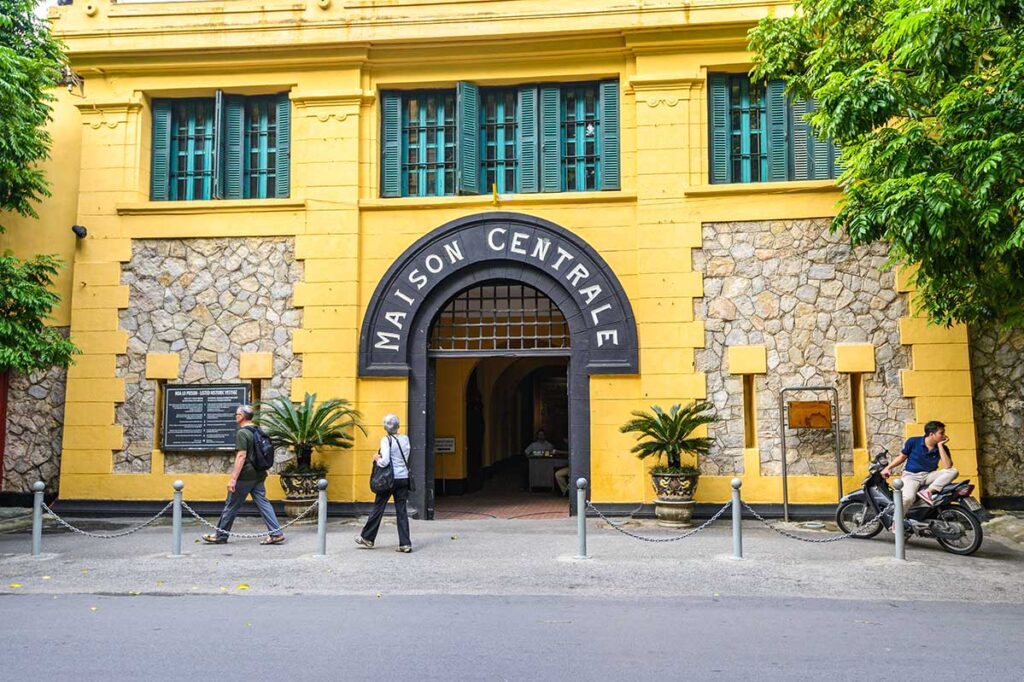
Next, head to Hoa Lo Prison, just 10 minutes on foot from the cathedral. Nicknamed the “Hanoi Hilton” by American POWs, this prison was originally built by the French to house Vietnamese revolutionaries and later used during the Vietnam War.
Inside, the exhibits are intense and sobering. You’ll see cramped cells, original shackles, and stories from both the French colonial and American wartime periods.
- Entrance: 50,000 VND (~$2 USD)
- Time: 45–60 minutes
- Note: The museum closes by 5:00 PM, so make sure to visit before late afternoon.
8. Street Food Tour (Evening) – Includes Train Street
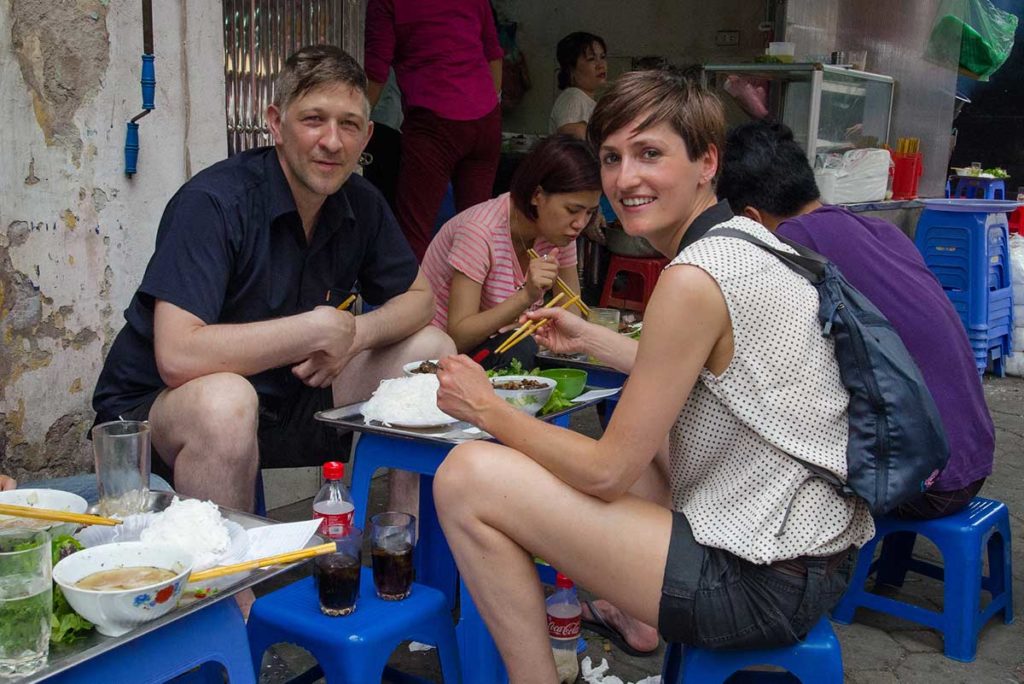
For dinner, skip the restaurants and join a guided street food tour — one of the best ways to experience Hanoi’s culinary scene. You’ll get to try local favorites like:
- Bun cha – grilled pork with noodles
- Nem ran – crispy spring rolls
- Banh cuon – steamed rice rolls
- Egg coffee – rich and creamy Hanoi specialty
Hanoi Street Food Tour
- Experience Try local dishes with a guide who knows hidden food spots and cultural stories.
- Includes Street snacks, traditional meals, and insights you’d miss exploring on your own.
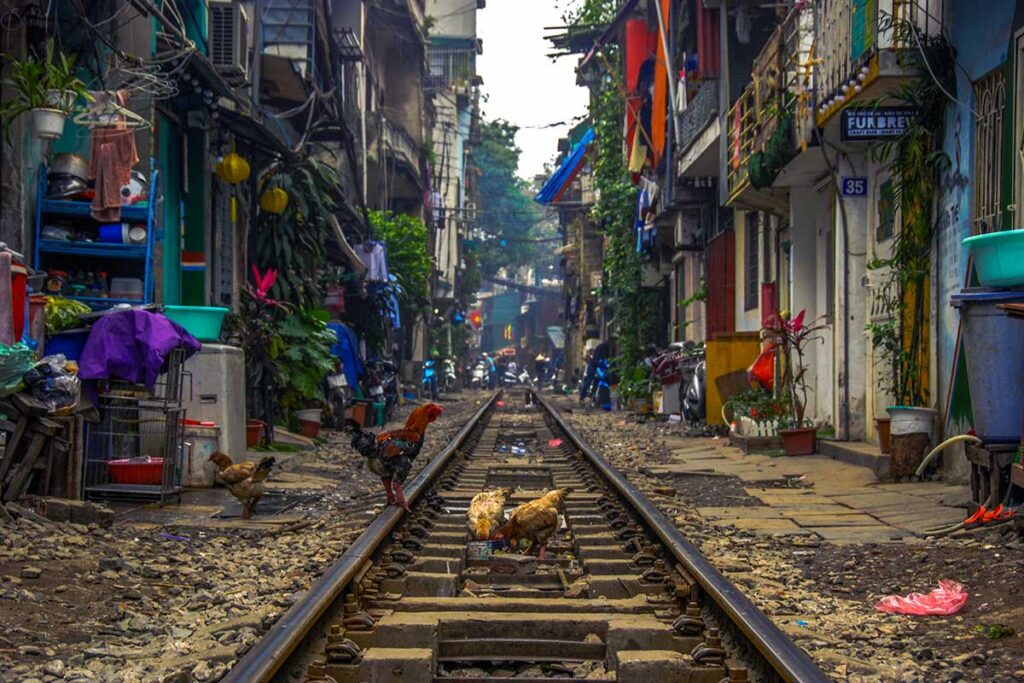
Most tours also include a stop at Hanoi Train Street (the legal café section near Tran Phu Street), where trains pass just inches from homes and cafés. Seeing it with a guide ensures you visit a permitted, safe area and catch the train schedule.
- Tip: Book a small-group or private food tour for a better experience — many start between 5:00 and 6:00 PM and last 3–4 hours.
9. Bia Hoi Corner or Rooftop Bar – Hanoi at Night
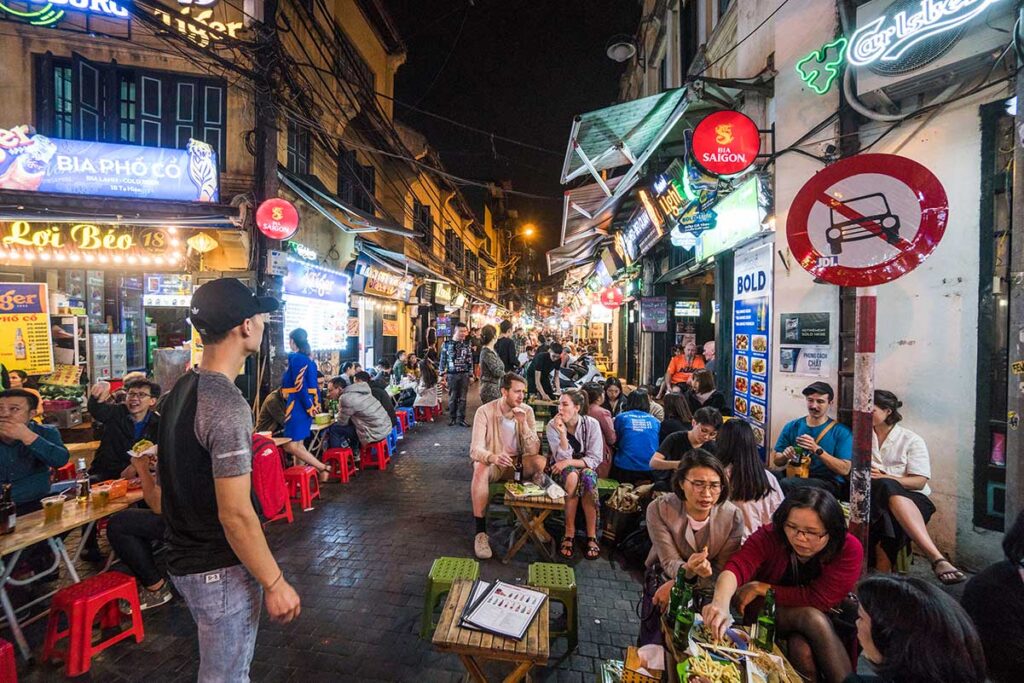
End your first day with a drink — and two very different options:
- Bia Hoi Corner (Ta Hien Street): This legendary backpacker hub is famous for plastic stools, cheap draft beer, and a raucous street atmosphere. It’s loud, fun, and great for people who enjoy crowds and street energy.
- Rooftop Bar: If you prefer something quieter with a view, head to a rooftop bar like Diamond Sky Bar, The Summit, or Twilight Sky Bar. Sip a cocktail while looking out over the rooftops of Hanoi — a relaxing way to end a packed day.
Day 2: Ba Dinh District & West Lake Extension
Hanoi’s political and historical heart, Ba Dinh District, is home to grand monuments, leafy avenues, and Vietnam’s most important political sites. Day 2 of you 3 day Hanoi itinerary takes you through Hanoi’s ancient and modern history — from Confucian scholars to revolutionary leaders. Start early to beat the heat and crowds.
1. Temple of Literature
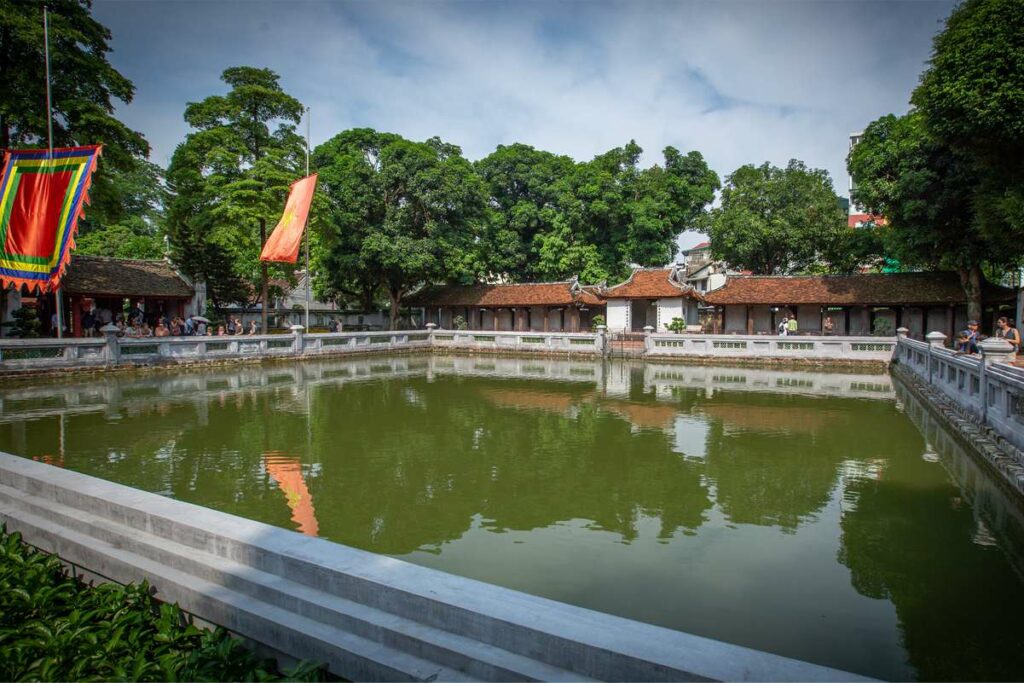
Begin your second day at the Temple of Literature, Vietnam’s first university. Founded in 1070 and dedicated to Confucius, it’s a peaceful, well-preserved complex with courtyards, pavilions, and stelae (stone tablets) listing the names of successful scholars from centuries ago.
It’s one of Hanoi’s most beautiful historic sites — quiet, green, and full of symbolism.
- Entrance: 30,000 VND (~$1.20 USD)
- Time: 45–60 minutes
- Tip: Try to arrive before 9:00 AM to enjoy the quietest atmosphere and soft morning light for photos.
2. Lenin Park (Lenin Statue & Skate Spot)
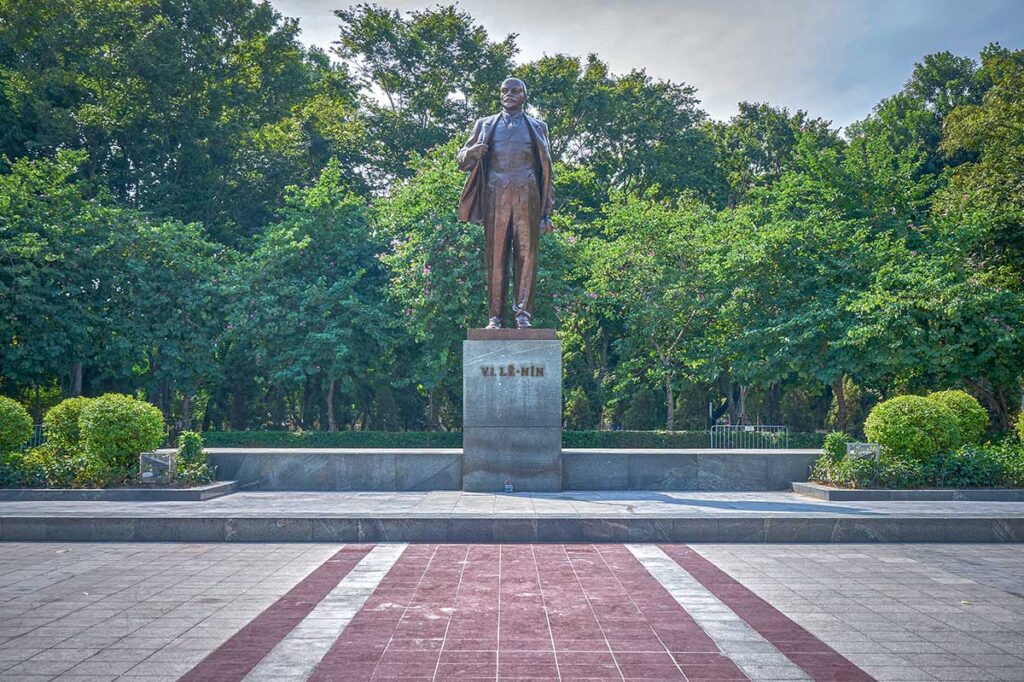
Just across the street is Lenin Park — not the big lake park, but the small triangle park featuring a large statue of Lenin. While not a sightseeing highlight on its own, it’s a fun and quick cultural stop. Locals often gather here to skateboard, do calisthenics, or just relax.
You don’t need long — but it adds a modern, local contrast to the historic monuments nearby.
3. Hanoi Flag Tower
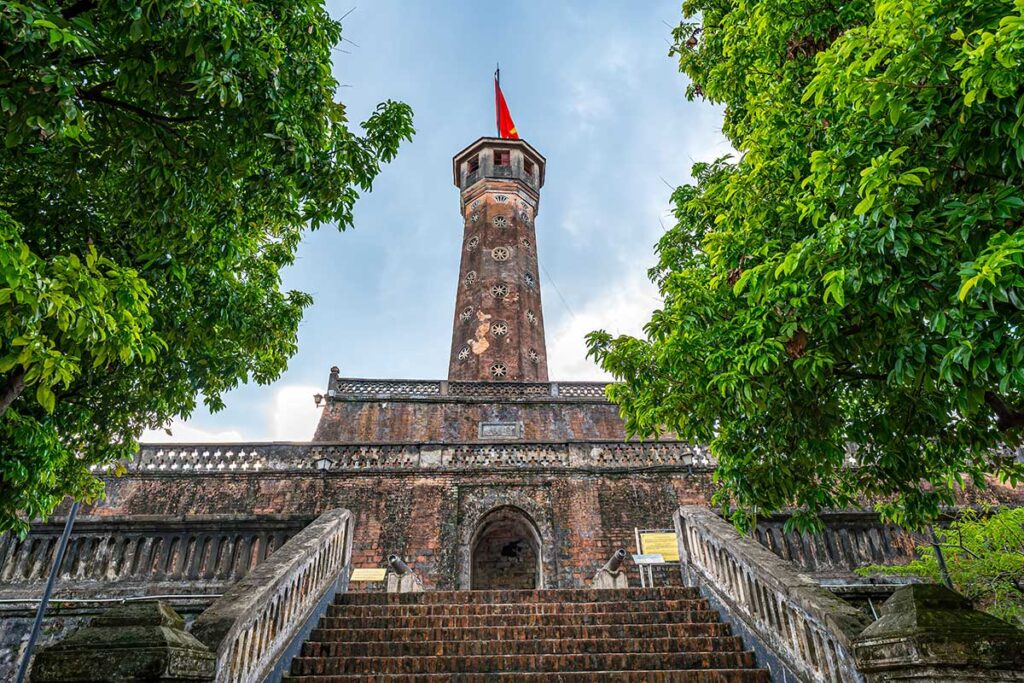
Next door stands the Hanoi Flag Tower, part of the original Hanoi Citadel and one of the oldest military structures in the city. The tower dates back to 1812 and was one of the few structures not destroyed by the French.
You can climb the tower for views over the military museum grounds and nearby streets — a short but rewarding stop.
- Time: 15–20 minutes
4. Imperial Citadel of Thang Long
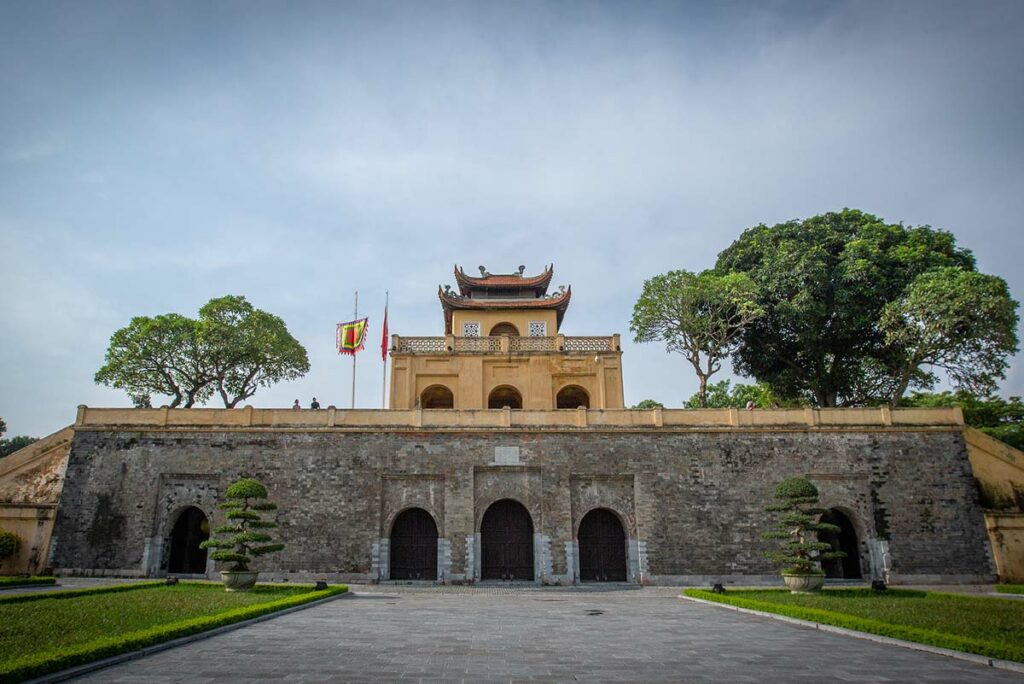
A 5-minute walk brings you to the Imperial Citadel of Thang Long, a UNESCO World Heritage Site that was once the seat of power for Vietnamese dynasties. Although much of the original complex was lost or buried, the reconstructed gates, archaeological sites, and old French bunkers give a sense of its layered history.
Key features include:
- Doan Mon Gate
- Hau Lau (Princess’ Palace)
- Excavated foundations showing relics from different eras
- Entrance: 30,000 VND (~$1.20 USD)
- Time: 60–90 minutes
- Tip: There’s minimal signage — consider hiring a guide or using an audio app for context.
5. Ba Dinh Square
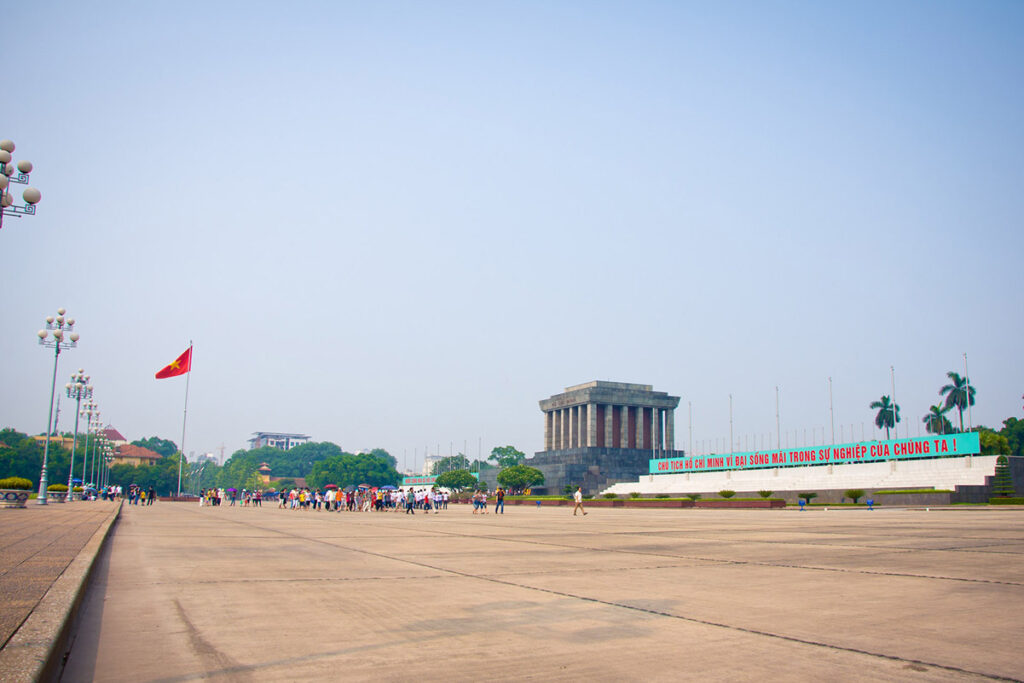
Walk north toward Ba Dinh Square, Vietnam’s ceremonial center. This massive plaza is where Ho Chi Minh read the Declaration of Independence in 1945. Today, it’s where military parades and official events are held.
It’s a wide open space framed by government buildings and palm trees — and always spotless. Walk along the edge or cross carefully at designated points.
6. Ho Chi Minh’s Mausoleum
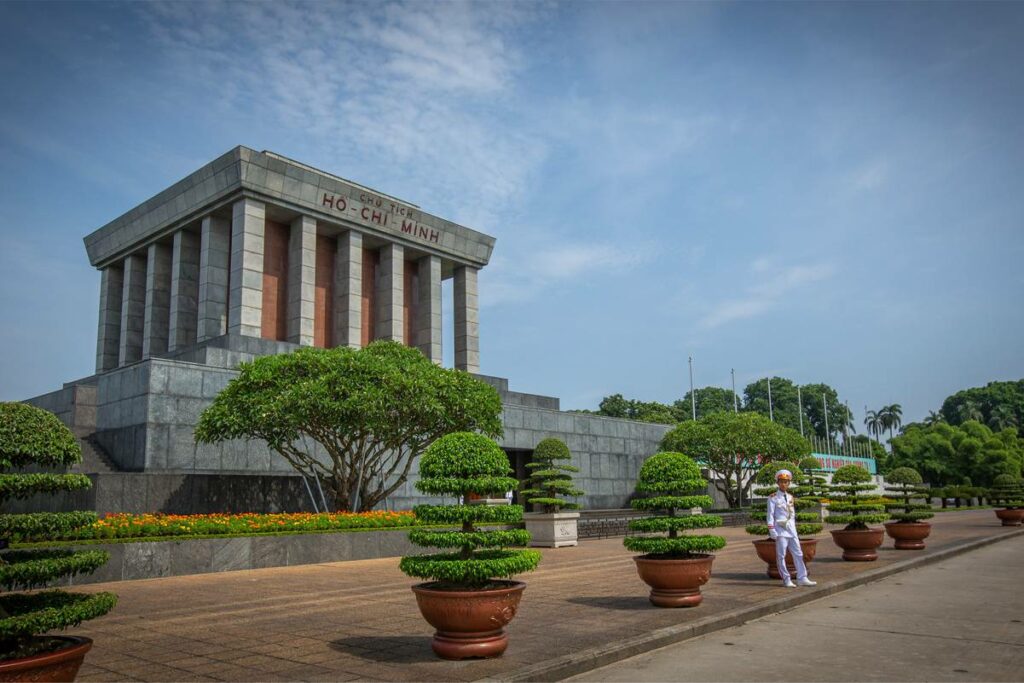
At the western edge of Ba Dinh square lies Ho Chi Minh’s Mausoleum, where the preserved body of Vietnam’s revolutionary leader lies in state. It’s a solemn, formal experience with tight security and a quiet atmosphere inside.
Entry is free, but:
- Opening hours: Morning only (closed Monday and Friday)
- Dress code: Shoulders and knees covered, no hats or phones inside
- Time: 30–45 minutes, including waiting time
Tip: If you’re not interested in entering, you can still admire the building and square from the outside.
7. Ho Chi Minh Museum
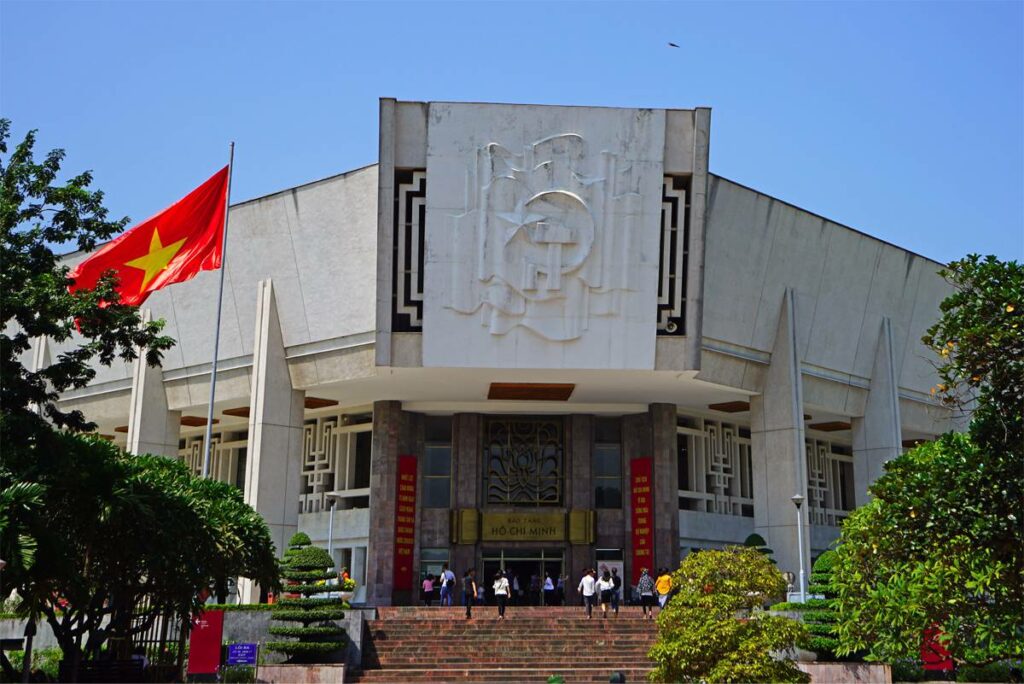
Right behind the mausoleum, the Ho Chi Minh Museum blends revolutionary history with abstract symbolism. It’s not everyone’s favorite — the layout is unusual, and some exhibits are ideological — but it offers insight into how modern Vietnam honors its founding leader.
Best for travelers curious about Vietnam’s 20th-century history or political narrative.
- Entrance: 40,000 VND (~$1.60 USD)
- Time: 30–45 minutes
- Note: Can be skipped if you’re short on time or museumed-out
8. One Pillar Pagoda
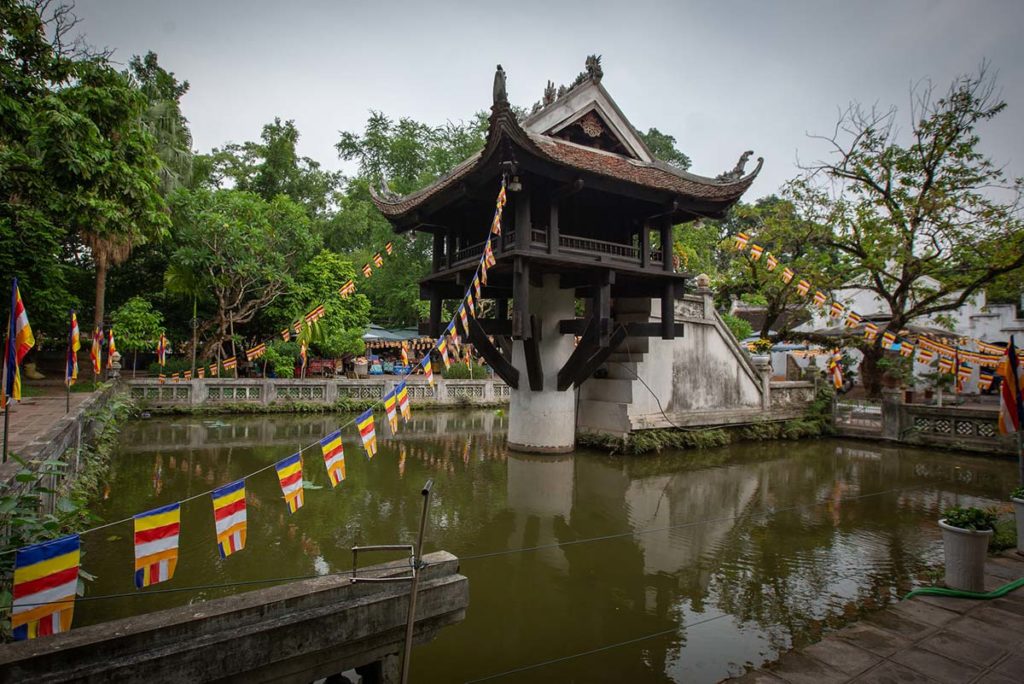
Tucked behind the Ho Chi Minh Mausoleum, the One Pillar Pagoda is one of Vietnam’s most iconic religious structures. Built to resemble a lotus flower rising from a pond, this small wooden temple was originally constructed in 1049 and symbolizes purity and rebirth.
It’s a quick visit, often crowded, but worth a stop for its symbolism and setting.
- Entrance: Free
- Time: 10–15 minutes
- Tip: Watch your footing on the steps — they’re steep and often slippery.
9. Ho Chi Minh’s Stilt House & Presidential Palace Grounds
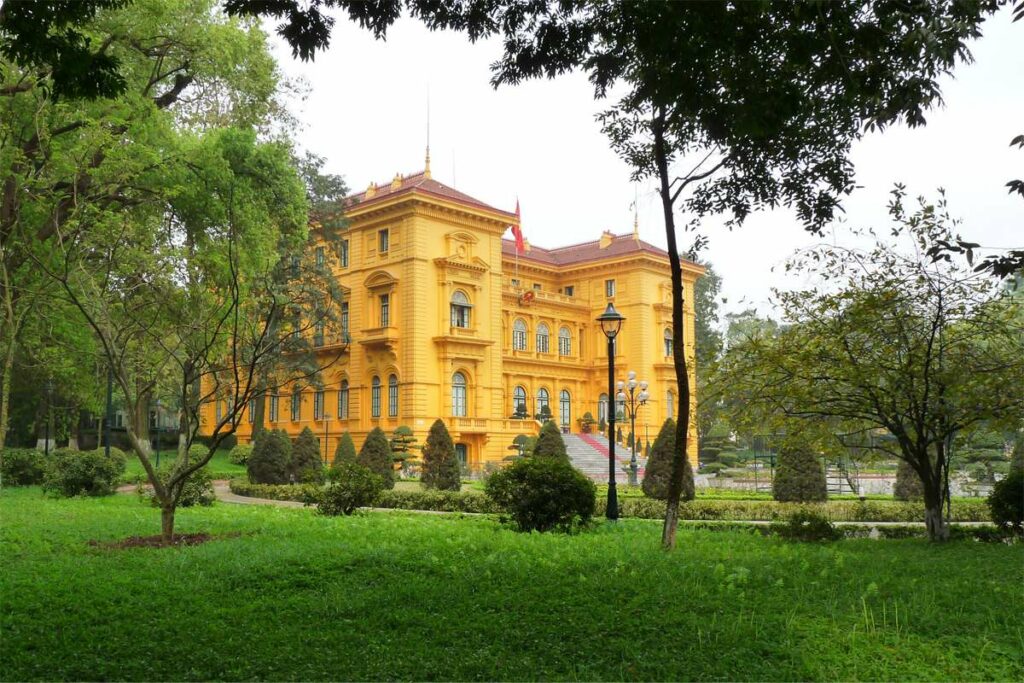
Just behind the mausoleum complex lies a quiet, leafy area where Ho Chi Minh’s Stilt House sits above a pond. Modeled after traditional houses in the countryside, this simple wooden home was where Uncle Ho chose to live instead of the opulent Presidential Palace, which still stands nearby but cannot be entered.
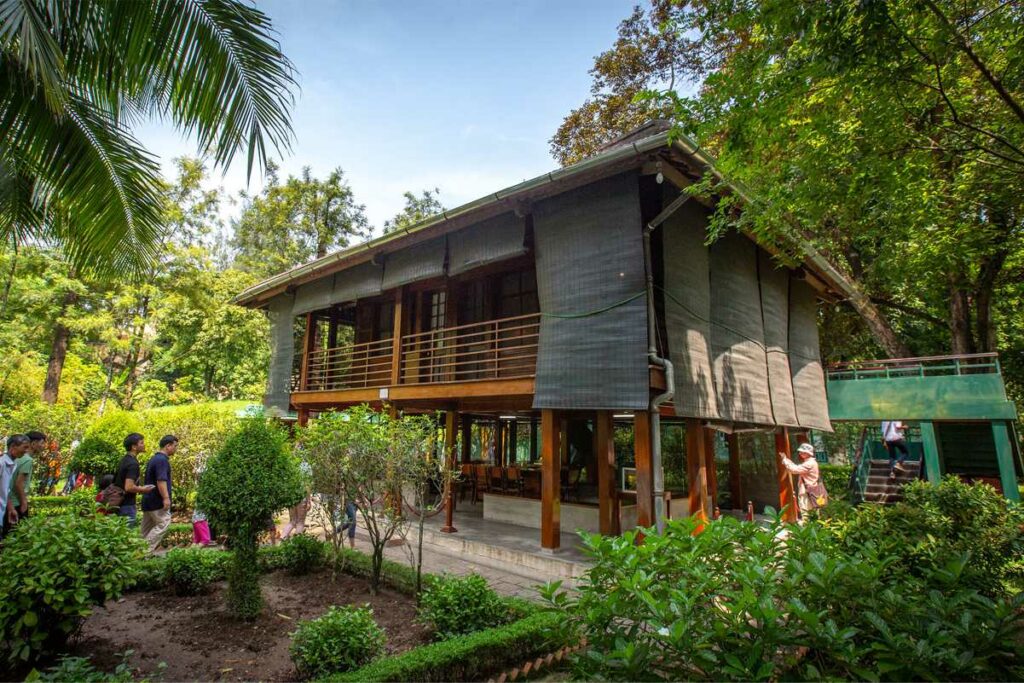
You’ll walk along a marked path, past his vintage cars and manicured gardens, offering a softer, more personal insight into his daily life.
- Entrance: Included with mausoleum complex
- Time: 30–40 minutes
- Note: Entry is one-way and usually moves quickly — photos allowed, but no access inside the house
10. Quan Thanh Temple
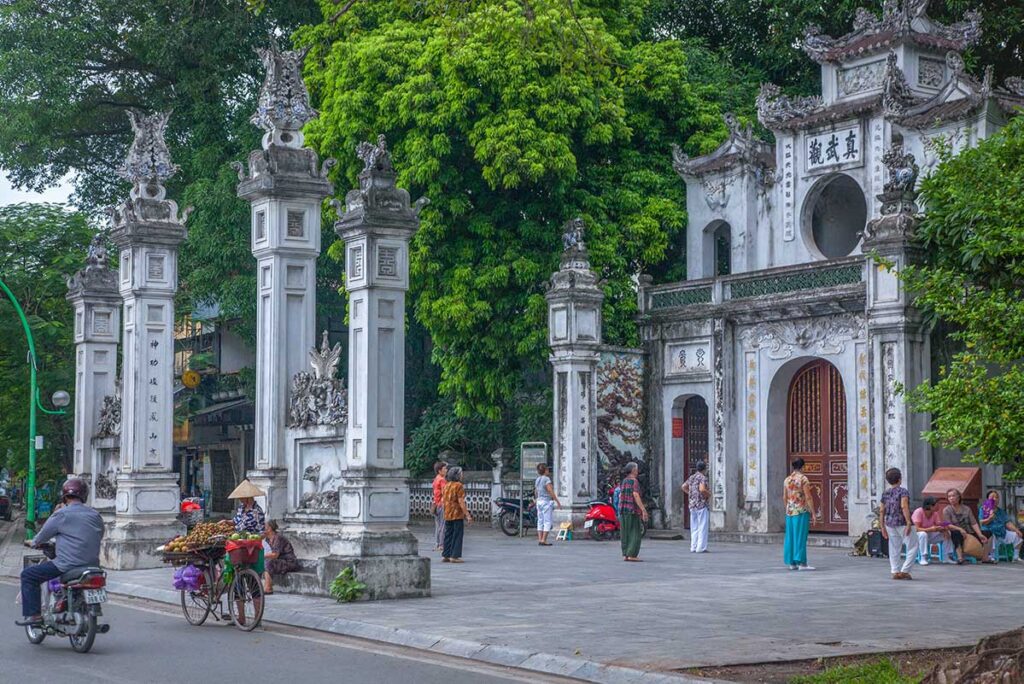
As you make your way toward West Lake, stop at Quan Thanh Temple, one of the Four Sacred Temples of ancient Thang Long. This 11th-century Taoist temple is dedicated to Tran Vu, the god of the North, and houses a towering bronze statue along with incense-filled altars.
The temple is calm and spiritual, with beautiful trees and a peaceful courtyard.
- Entrance: 10,000 VND (~$0.40 USD)
- Time: 20–30 minutes
- Tip: Wear shoes that are easy to remove — you’ll need to take them off to enter the inner sanctuary.
11. Tran Quoc Pagoda
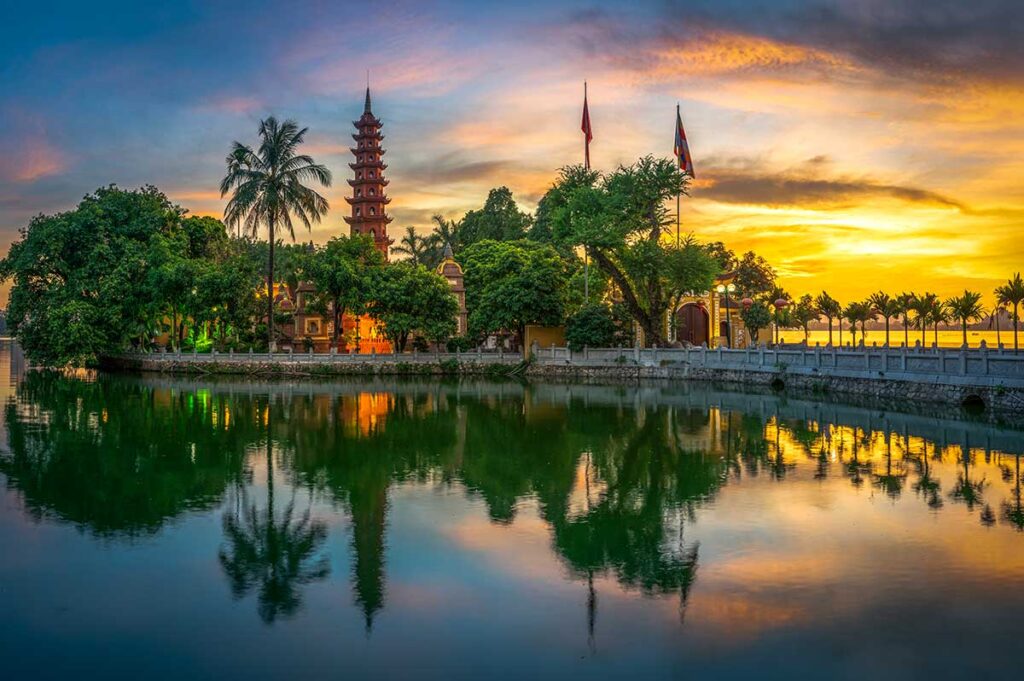
Next up is Tran Quoc Pagoda, Hanoi’s oldest pagoda, located on a small island in West Lake. Its red-brick tower rising above the water is one of the city’s most photogenic religious sites. Originally built in the 6th century, it’s been restored many times but retains a strong spiritual atmosphere.
Arrive just before sunset for beautiful light on the water.
- Entrance: Free
- Time: 20–30 minutes
- Best time: Late afternoon to sunset
- Tip: It can get busy — be patient and respectful, especially around praying locals.
12. West Lake
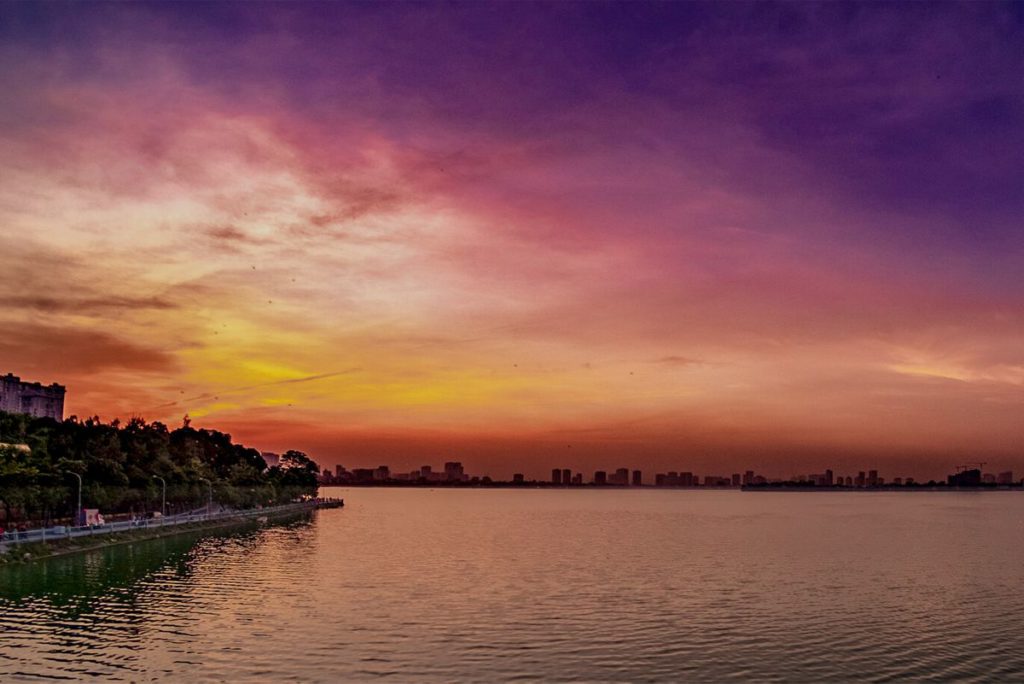
If you have the energy, spend some time walking or relaxing by West Lake — Hanoi’s largest lake. Unlike Hoan Kiem, this lake feels more open, breezy, and residential, with a mix of upscale cafés, lotus ponds (in season), and quiet alleys.
Ideas for enjoying it:
- Rent a bicycle or cyclo for a relaxed ride
- Have a drink or snack at a lakeside café (e.g., Maison de Tet Decor, or The Hanoi Social Club’s lakeside branch)
- Walk a short stretch of Thanh Nien Road, a causeway dividing West Lake and Truc Bach Lake
It’s a great place to unwind before heading into the evening.
13. Water Puppet Show (Evening)
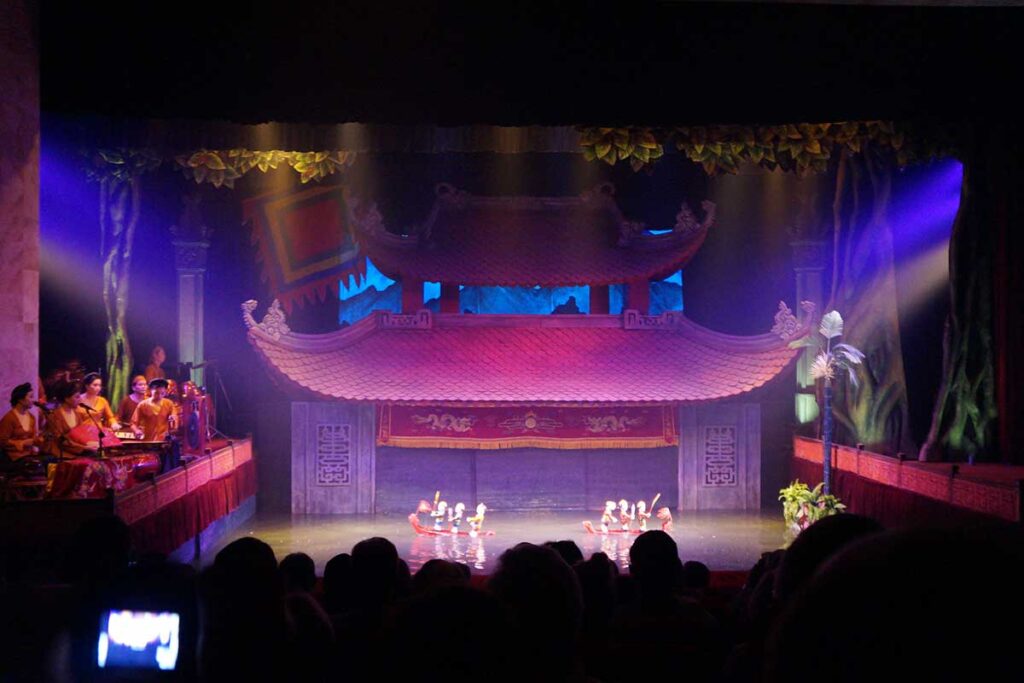
Wrap up Day 2 with a traditional water puppet performance — a unique northern Vietnamese art form involving wooden puppets, live music, and water stages. Shows usually last 45–60 minutes and are surprisingly charming, even for adults.
The most famous venue is Thang Long Water Puppet Theatre, near Hoan Kiem Lake.
- Times: Multiple daily shows, usually from 4:00 PM to 8:00 PM
- Tickets: From 100,000 VND (~$4 USD); best to book in advance
- Tip: Arrive 10–15 minutes early to get settled and choose a seat with a good view of the middle
Day 3: Missed Highlights of Hanoi
Your final day of this 3-day Hanoi itinerary covers a mix of overlooked highlights. If you’ve already covered the essentials in the first two days, this third day gives you time to explore areas often skipped on shorter visits — including an upgraded museum, quiet corners of the French Quarter, and some of the city’s best architecture. It’s also a chance to move at your own pace and follow personal interests.
1. Vietnam Military History Museum (New Location)
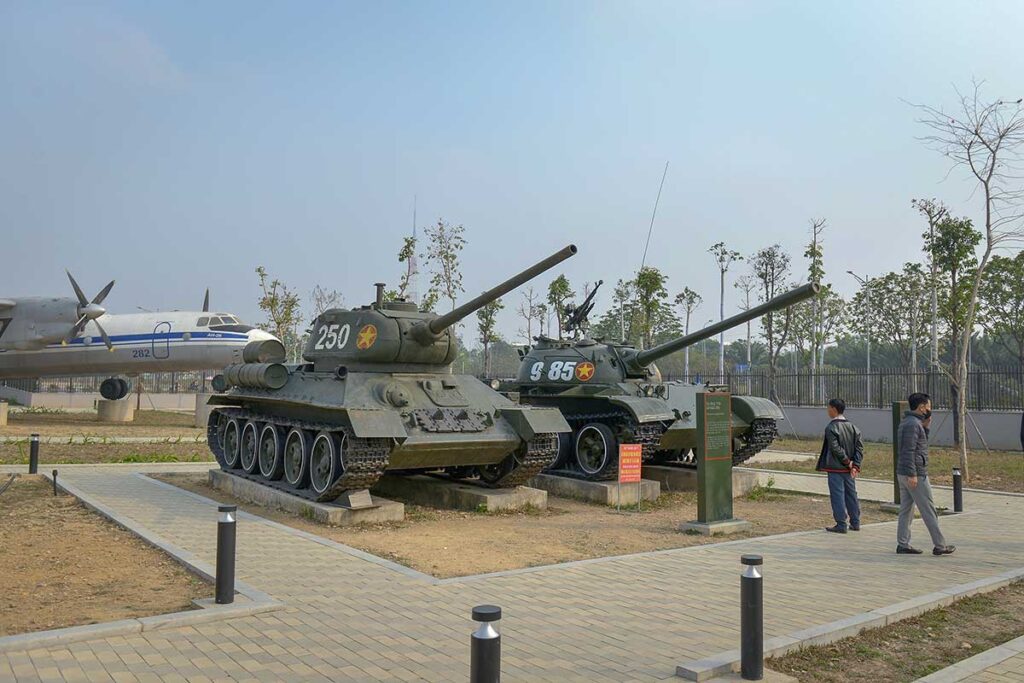
The Vietnam Military History Museum was completely relocated and expanded in 2024. It used to sit next to the Flag Tower and Citadel, but now it’s in a much larger building farther from the center — harder to combine with Ba Dinh sights, but well worth the ride.
The new exhibits are better curated and more engaging than the old version, covering Vietnam’s military history from ancient times to the 20th century wars, with aircraft, tanks, and personal stories.
- Time: 60–90 minutes
- Location: Not walkable from other major sights — plan a Grab or taxi
- Why it’s worth it: One of the best revamped museums in Hanoi, especially if you’re interested in war history
Pro Tip: On the way there, ask your Grab driver to make a quick stop at B-52 Lake (Huu Tiep Lake) — a small pond in a residential neighborhood where the wreckage of an American B-52 bomber still sits in the water. There’s not much to do beyond a photo and a look, but it’s a unique historic stop if you have 5 minutes.
2. Ly Thai To Park, Toad Fountain & Dinh Le Book Street
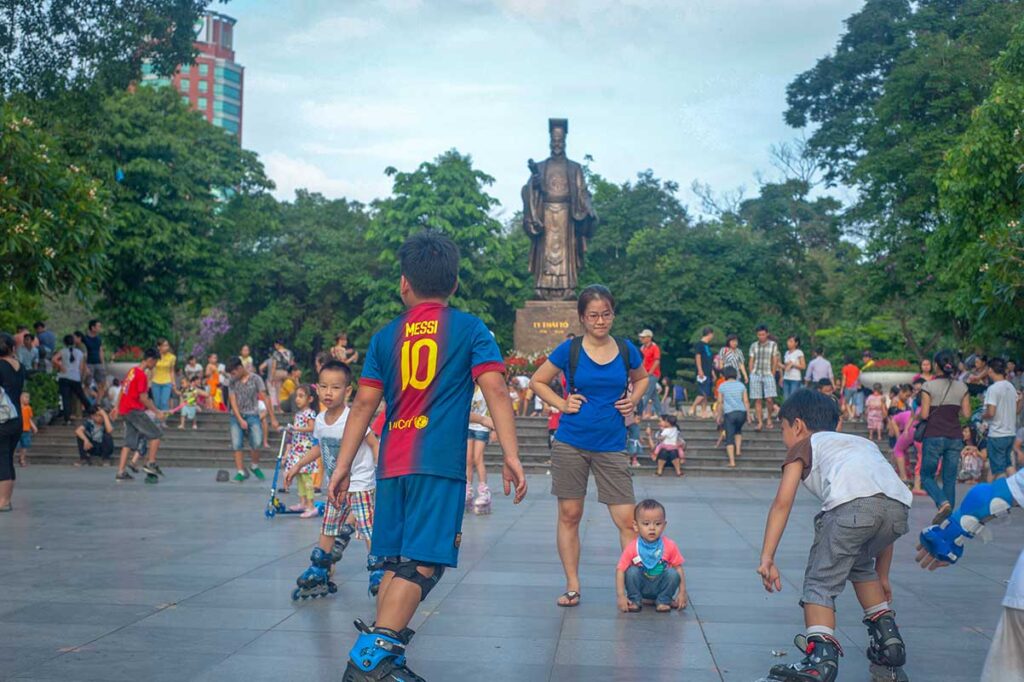
Then take a taxi from Vietnam Military History Museum to the southeast side of Hoan Kiem Lake, a part of the French Quarter.
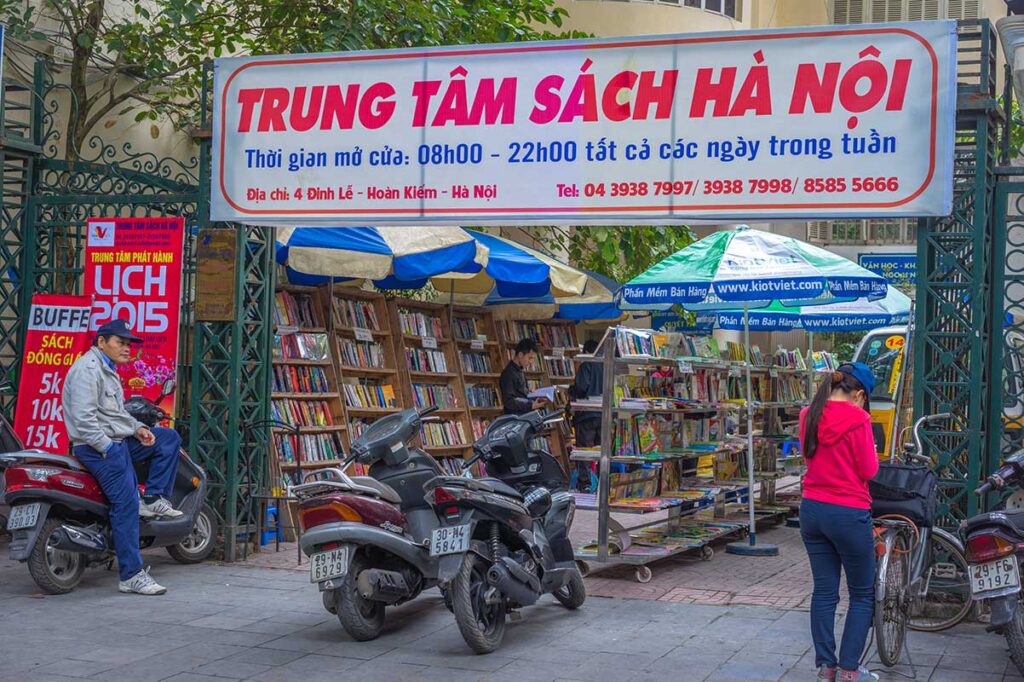
This quiet corner of the French Quarter, is often overlooked by tourists. But it’s one of the best places in Hanoi to slow down and watch daily life.
- Ly Thai To Park is a peaceful open space with trees, benches, and a large statue of the emperor who founded Hanoi as the capital in 1010.
- The Toad Fountain nearby is a classic French-era structure surrounded by local chess players, couples, and families.
- Around the corner is Dinh Le Book Street — the original book street of Hanoi, where you’ll find narrow shops stacked with Vietnamese novels, textbooks, and comics. It’s more chaotic than the newer book street near the cathedral, but full of charm.
These spots are all within a few steps of each other, and ideal for a relaxed morning or afternoon stroll.
3. Hanoi Opera House
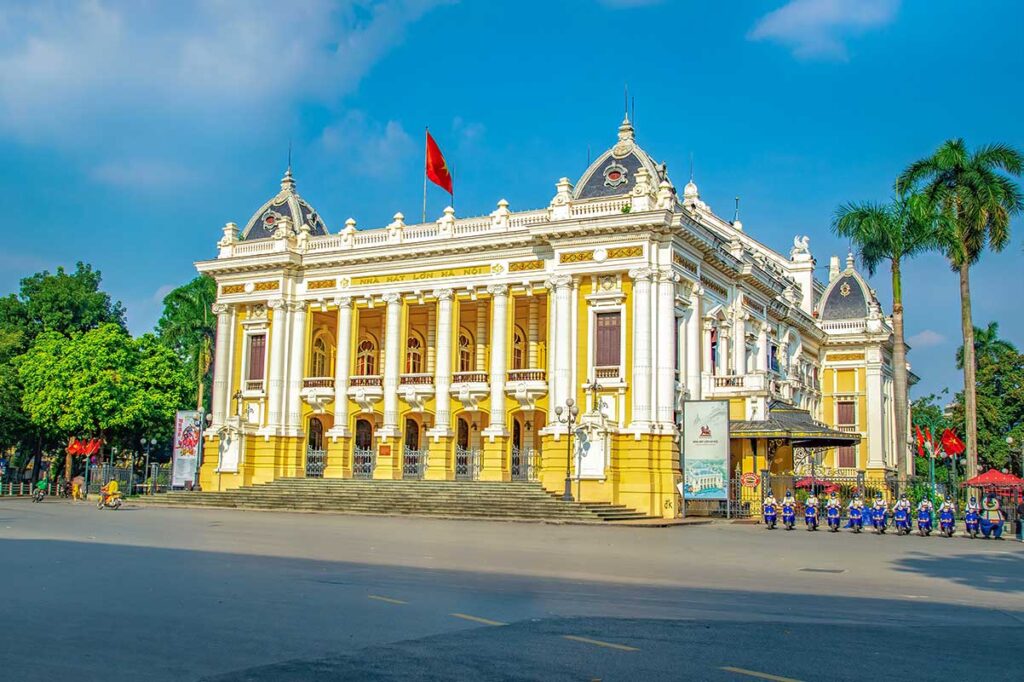
From Ly Thai To Park, it’s a short walk to the stunning Hanoi Opera House, one of the finest French colonial buildings in Vietnam. Built in 1911 and modeled after the Palais Garnier in Paris, it’s still in active use today.
You can admire the exterior from the square or book a seat at an evening performance — opera, ballet, or orchestral concerts depending on the season. Even a basic ticket gives you access to the lavish interior, which most travelers never see.
- Entrance: Free to view from outside; ticket prices vary for shows
- Tip: Walk past the Sofitel Legend Metropole Hanoi, just across the street — it’s one of Southeast Asia’s most famous heritage hotels, with a bomb shelter tour available inside.
4. Vietnam National Museum of History
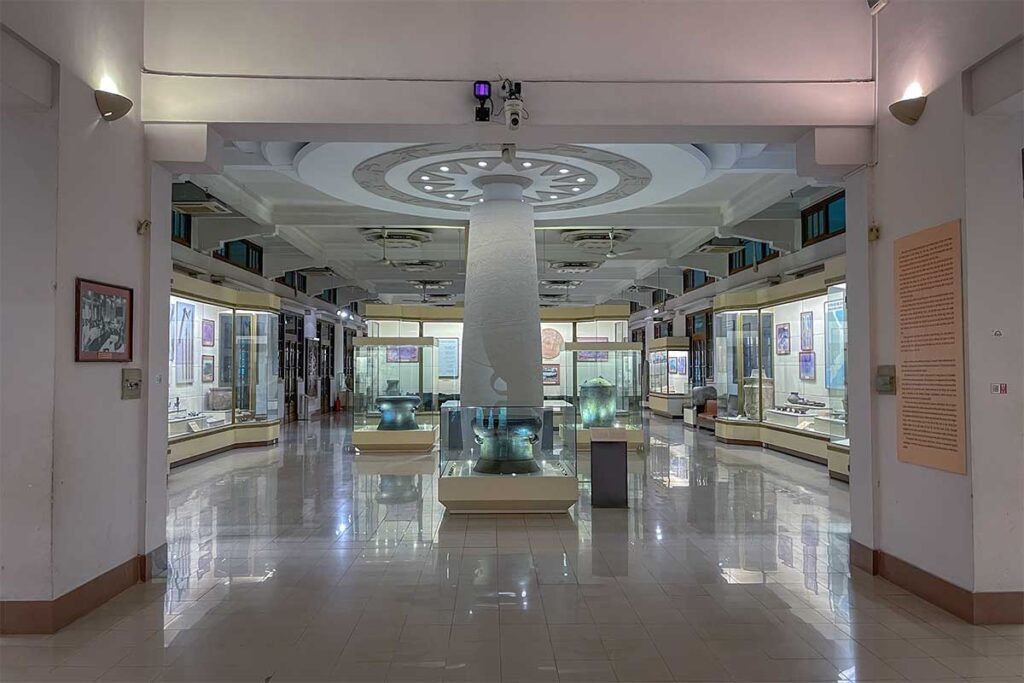
Tucked behind the Opera House, the Vietnam National Museum of History is housed in another elegant colonial building, once home to the French School of the Far East. The museum traces Vietnamese history from prehistoric times through to the Nguyen dynasty, with sculptures, ceramics, bronze drums, and royal artifacts.
While it’s not interactive and won’t appeal to everyone, it’s worth visiting for the architecture alone — or for history buffs looking for depth beyond the usual war-focused museums.
- Entrance: 40,000 VND (~$1.60 USD)
- Time: 45–60 minutes
- Tip: You can skip the museum itself and still enjoy walking through the leafy grounds and admiring the building’s facade.
5. Hom Market – Fabrics & Local Vibes
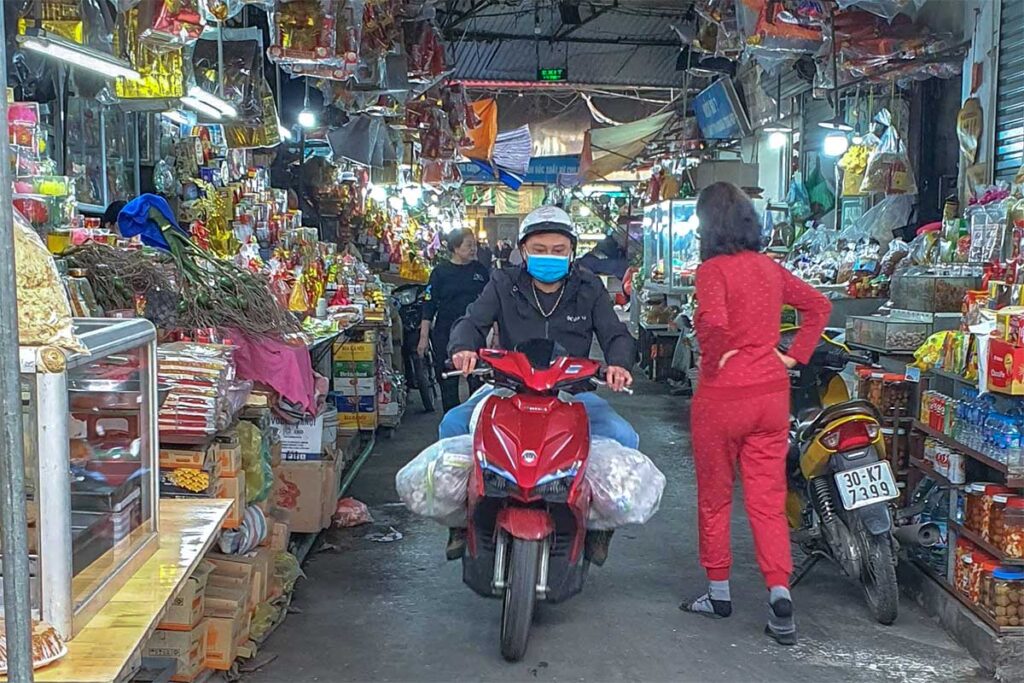
Located just south of the French Quarter, Hom Market isn’t made for tourists — but that’s exactly what makes it interesting. Downstairs you’ll find daily produce and household goods, but head upstairs to the fabric section, where stall after stall sells colorful rolls of silk, cotton, and brocade.
Even if you’re not shopping, it’s a great place to observe daily commerce and browse the patterns. Tailors and designers often come here to source materials, and you’ll see locals haggling over bolts of fabric for traditional ao dai or custom suits.
- Entrance: Free
- Time: 20–30 minutes
- Tip: It’s hot and a bit cramped upstairs — go earlier in the day or dress light.
6. Thong Nhat Park – Local Life in Late Afternoon
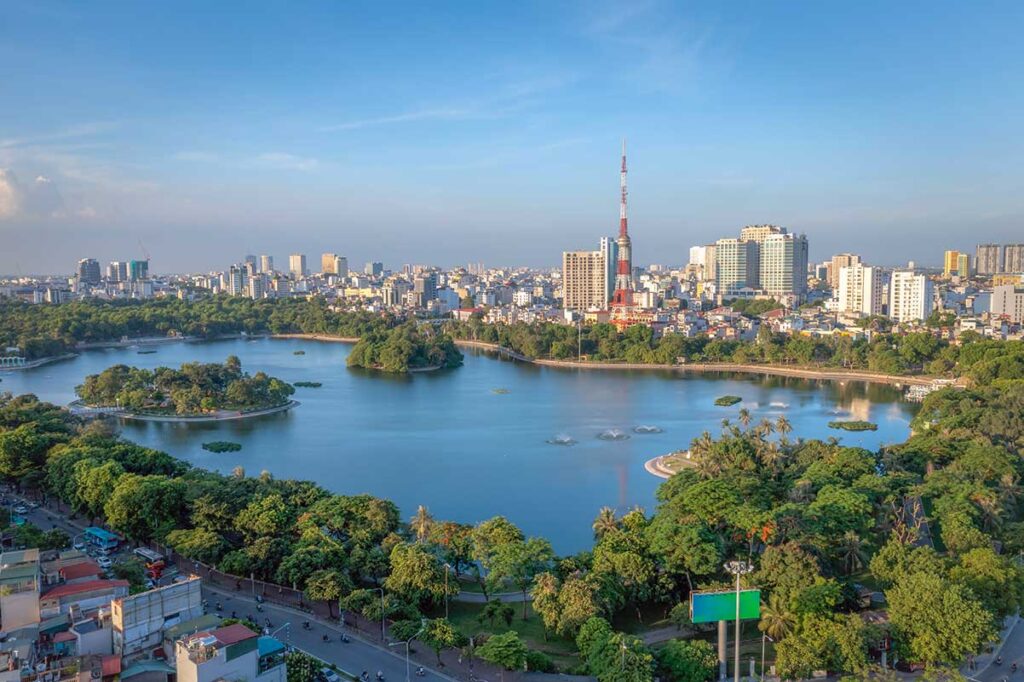
Just a 10-minute walk from Hom Market, Thong Nhat Park (also known as Reunification Park) is one of the largest green spaces in Hanoi. It’s not the most scenic — think wide paths, open lawns, and a central lake — but it’s peaceful, quiet, and a great escape from the city’s traffic and honking.
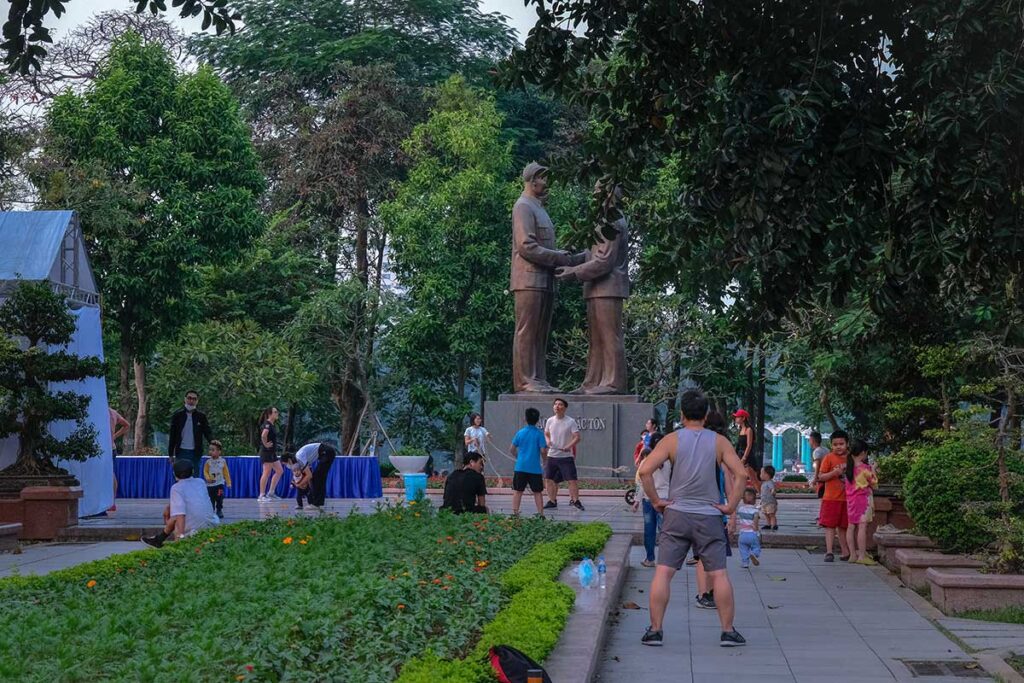
Late afternoon is the perfect time to come. As the sun goes down, the park fills with Hanoians walking, jogging, dancing, or chatting on benches. It’s a calm, lived-in space where you can take a breather before heading back to the Old Quarter for your final evening.
- Entrance: 4,000 VND (~$0.15 USD)
- Time: 30–45 minutes
- Why visit: A relaxing pause and a window into local rhythms, especially nice at golden hour
7. Return to the Old Quarter
Wrap up your 3 days in Hanoi back where it all started — in the Old Quarter. Depending on your mood and timing, you can:
- Grab a final bia hoi at a street corner
- Pick up souvenirs at the night market or local boutiques
- Squeeze in a last bowl of pho or banh cuon
- Just wander one more time through the buzzing, lantern-lit alleys
No matter how you spend your last evening, Hanoi is a city that leaves strong impressions — and you’ll likely find yourself wishing you had one more day.
Alternatives for day 3 in Hanoi
Not everyone wants to spend all 3 days in Hanoi focusing on historical sights and city streets. If you’re looking for a different experience on your final day, there are plenty of alternatives — both outside the city and in Hanoi’s outer districts. Here are two good directions to consider.
Option 1: Day trips from Hanoi
If you’re spending 3 days in Hanoi but want to get out of the city on your last day, these day trips offer a refreshing change of scenery.
Tip: Read more in our full guide Best day trips from Hanoi
Ninh Binh

Known as “Halong Bay on land,” Ninh Binh is famous for its limestone karst landscapes, boat rides through rice fields, and ancient temples like Hoa Lu. Tam Coc and Trang An are the main highlights — where you can glide down peaceful rivers between sheer cliffs. It’s a long but manageable day trip from Hanoi, though staying overnight allows you to explore more.
Perfume Pagoda
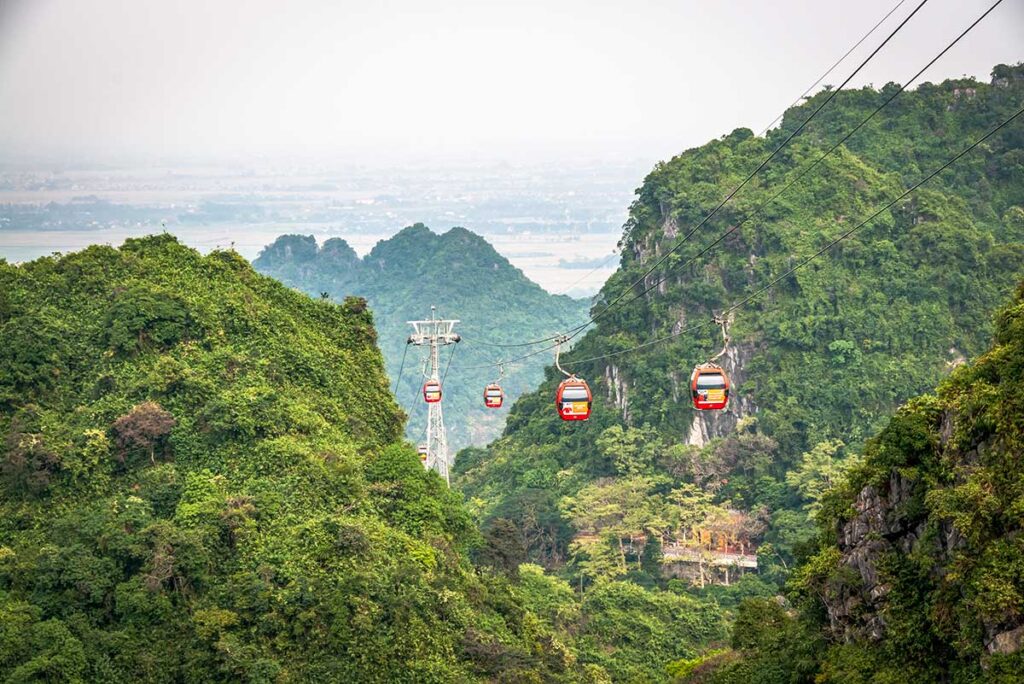
The Perfume Pagoda is a popular spiritual day trip that takes you into a peaceful mountain area southwest of Hanoi. You’ll ride a small boat down a quiet river, then hike or take a cable car to reach the main cave pagoda. It’s a scenic, cultural experience — best visited outside the hottest summer months.
Halong Bay
While we recommend staying overnight if possible, it is technically possible to visit Halong Bay on a long day trip from Hanoi. You’ll spend about 3–3.5 hours each way by road, but once you arrive, you can enjoy a short cruise past limestone islands, caves, and floating villages. If you only have 3 days in Hanoi and want a quick taste of the bay, this is an option — but expect a very full day.
Option 2: Outer Parts of Hanoi
If you want to stay closer but still escape the Old Quarter, Hanoi’s surrounding districts offer more local experiences and traditional craft culture. These ideas work well for a relaxed final day.
Craft Villages
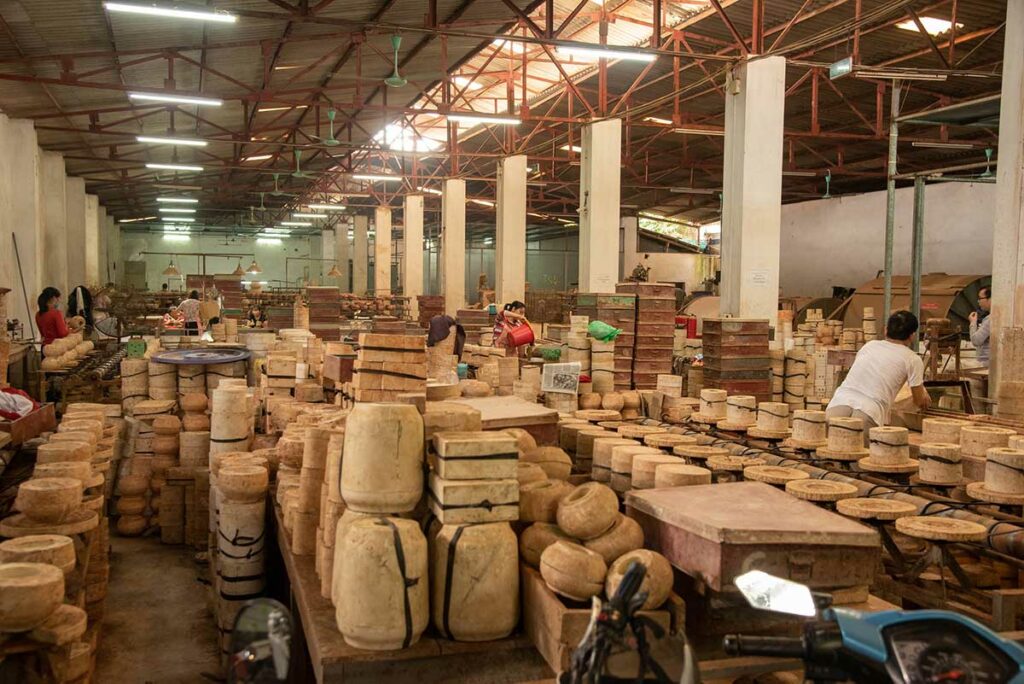
Around Hanoi are dozens of traditional villages that still specialize in handicrafts. The most famous is Bat Trang, a ceramic village with centuries of history and hands-on pottery workshops. Van Phuc is known for silk weaving, and Quat Dong for embroidery. Visiting these villages gives you a look into local life outside the tourist zones.
Pagodas and Spiritual Sites

Hanoi has hundreds of temples and pagodas, but a few major ones sit on the outskirts. Tam Chuc Pagoda, one of the largest in Southeast Asia, is set in a dramatic lake-and-karst landscape. Yen Tu Pagoda, further northeast, is a major pilgrimage site — best visited as part of a full-day or overnight trip. These places offer a peaceful and spiritual contrast to city life.
Historic Sites
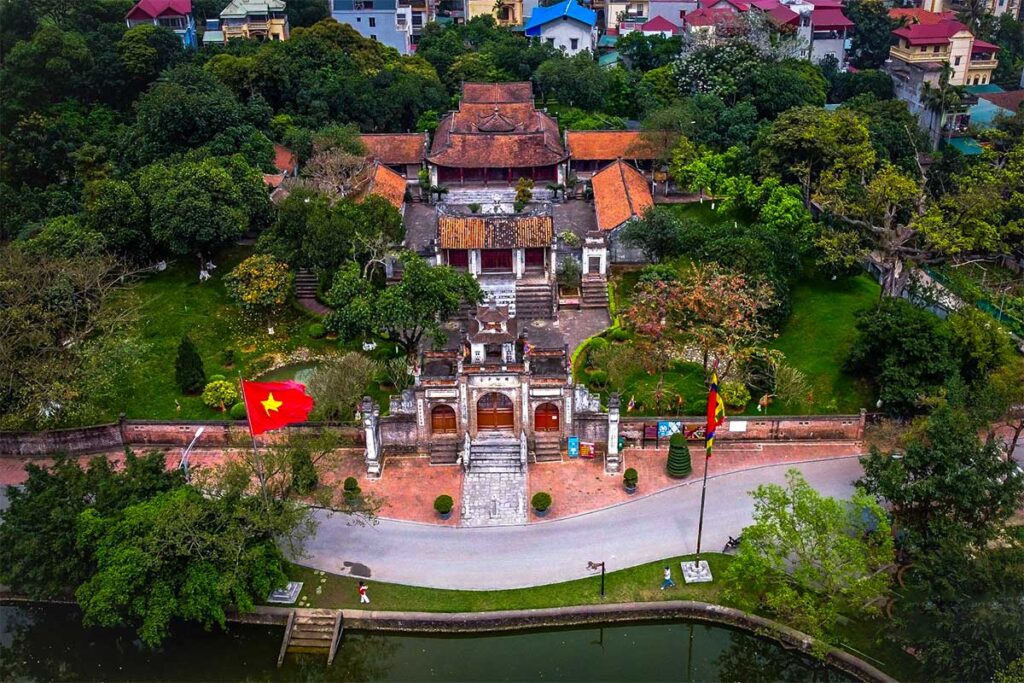
If you enjoy history, Co Loa Citadel is one of Vietnam’s oldest capitals, dating back to the 3rd century BCE. Located just outside Hanoi, it offers old ramparts, legends, and temples in a quiet countryside setting. It’s not on most tourist itineraries, which makes it feel more authentic.
Neighboring Provinces
For those who want to escape the city and experience daily life where almost no tourists go, consider short trips into provinces like Bac Ninh (known for folk music and ancient temples), Vinh Phuc, or Hung Yen. These areas offer a look at rural northern Vietnam without curated tourist stops — best visited with a private car or local guide.
Travel tips for visiting Hanoi in three days
A 3-day Hanoi itinerary gives you more flexibility — but it also means a bit more planning. Here are some practical tips to help you get the most out of your time in the city.
Walking
Day 1 and Day 2 of this 3 days in Hanoi itinerary are designed around walking. Most sights are clustered close together in the Old Quarter, French Quarter, and Ba Dinh District. You’ll be walking through vibrant streets full of markets, cafés, and everyday scenes — so take your time and enjoy the in-between moments.
Day 3 covers sights that are more spread out, like the Military History Museum or Hom Market. You’ll need to rely more on taxis or Grab (car or motorbike) — or consider booking a private car if you prefer convenience or want to string together stops efficiently.
Flexible itineraries
This 3-day Hanoi itinerary is a suggestion, not a strict schedule. Some people like to explore museums in detail; others prefer to focus on the atmosphere and move quickly. Feel free to skip, rearrange, or swap in alternative sights. The only places that require early timing are the Mausoleum (morning only) and any pre-booked shows.
If you’ve already seen a few of the suggested stops — or want something less conventional — check Section 7 for alternative ideas and easy day trips from Hanoi.
What to prepare
- Internet: Get a local SIM card or eSIM. It’s essential for Google Maps, translations, and checking attraction hours.
- Cash: Many street food stalls and smaller shops only accept cash. Have small denominations ready.
- Comfortable shoes: Hanoi’s sidewalks are uneven, and you’ll be walking a lot.
- Day bag: A small backpack is handy for water, tickets, sunscreen, or a camera.
- Light rain gear: Especially during the rainy season (May–September), bring a foldable raincoat or umbrella.
Ticket timings
- Ho Chi Minh’s Mausoleum: Only open in the morning (typically 7:30–10:30 AM), closed Mondays and Fridays.
- Water Puppet Show: Book tickets a day ahead, especially for weekend evenings.
- Opera House: Check the schedule in advance if you want to attend a performance. Daytime access is limited unless you book a tour.
- Museums: Most close around 4:30 or 5:00 PM. Some shut for lunch between 11:30 AM and 1:30 PM.
Weekend Night Market
If your 3 days in Hanoi include a Friday, Saturday, or Sunday night, make time to explore the weekend night market. The streets around Hoan Kiem Lake close to traffic in the evening, creating a festive walking zone full of street performers, families, and pop-up stalls. It’s especially lively between 7:00 PM and 9:00 PM, and offers a fun, relaxed way to end your day.
